|
Prince Charles explains 'pebble theatre'.
|
PEBBLE
|
|
Don Pierson [right] explains how a young Prince Charles made a request to join the Radio London fan club. |
|
|
Prince Charles explains 'pebble theatre'.
|
PEBBLE
|
|
Don Pierson [right] explains how a young Prince Charles made a request to join the Radio London fan club. |
|
|
As we began to explain yesterday for the very first time anywhere, the beginning of Radio Caroline was as an offshoot from Radio Atlanta, but it still remained one project. But it did not begin with a fable that Ronan O'Rahilly's father was a wealthy man who was visited as a potential investor by Australian Allan James Crawford. Yet that is the way in which the subject of Greenore, Eire, is always introduced and referred to in the host of newspaper and magazine articles; books; audio accounts on radio, and video explanations on television. They begin with a statement and then move on to another point very quickly in an attempt to deceive their readers, listeners and viewers on this subject. Those recitals by so-called 'experts' are all bogus; false; rubbish; nonsense, and contradictions of documented fact! Usually they overcome their 'problem' with the truth by skipping right over it. Our favorite example of this process Is the basis for a skit in early Steve Martin comedy routines. You should listen to it: https://www.youtube.com/watch?v=T28ouCAUl4w Let me give you some classic examples of what I call the 'Steve Martin Process', as it applies here:
Before Radio Caroline there was little in the way of pop music being broadcast in the UK: False. Before Radio Caroline even emitted a test signal the Beatles were already big in the UK and beginning to take the USA by storm. How was that possible? The Beatles were not alone in this tidal wave of sound. How could that possibly be true? But it is. Georgie Fame wanted to make a record, but he was unable to do so, His manager Ronan O'Rahilly made a demo and tried to get the BBC to play it, and then Radio Luxembourg. No go. "Right!" exclaimed Ronan, "I have to start my own radio station". But he didn't and he wasn't Georgie Fame's manager and EMI had alreadly released an LP by Georgie Fame, months before Radio Caroline came on the air. Ronan O'Rahilly had a wealthy father who owned the only private port in Ireland, so Ronan did a deal with Allan Crawford and both his radio ship, and Ronan's radio ship were outfitted there. Well, Ronan's dad was not wealthy and he did not own a private port in Ireland and Radio Caroline had been partially outfitted in Rotterdam by Wijsmuller. Ronan flew to Texas to buy some transmitters and on his way he saw a picture of five years old Caroline Kennedy crawling under her Dad's desk, and he was the President of the USA, and she did this in front of diplomats which caused serious discussion to cease. "Right!" said Ronan. "I will name my station after her, it will be called 'Radio Caroline'." But none of that is true and the myth about Caroline Kennedy did not begin until the Spring of 1965. However, as these examples show, you first make a definitively bold statement and then, before anyone has a chance to question its authenticity, you move on to the next point which you expand upon in great detail. Now no one remembers what your first point was, but the next time you make that same first point, it will be accepted as an existing and unquestioned statement of truth. That's how this game has been played - until now. Paul Rusling was just the latest to try it out after stealing his foundational work, and then he twisted it to fit the old myths. But his time is now up! Here comes the person who peers behind the curtains of deception! All of these various previously published explanations about the start of Radio Caroline all mention a hodge-podge of seemingly unconnected attempts to start offshore radio stations. Then they end-up with an old fuddy-duddy like Allan Crawford who is then out-smarted by a young and vibrant Ronan O'Rahilly. Ronan may not have got the 'Steve Martin' approach from Steve Martin, but Ronan O'Rahilly was so full of crap it was portrayed as cow pancakes, it made sensible people following in his footsteps be very careful where they trod. Most of his followers plodded on through his fields of dung and consequently their works stink of rotting rubbish. This is where all of that gets flushed down the toilet. So whereas Steve Martin intended to make his audience laugh, the O'Rahilly hacks tend to pick your pockets by getting you to pay for their rubbish, and then they laugh at you for being such a fool. Hey, it worked up until now. It worked for Paul Rusling and he even had the audacity to call his nonsense a 'bible', which it is: a bible of nonsense. We have already established that Ronan's father was cash-strapped and was looking for his own investors. That alone makes nonsense of the idea that Ronan would suggest to Allan Crawford that he should hit his father up for money in order to finance Radio Atlanta. But that is what all of the nonsense authors tell you that he did. We are showing you why that didn't happen, and why Crawford would not have been stupid enough to attempt it. It becomes apparent that the use of Greenore, Eire to outfit the mv Fredericia and mv Mi Amigo was a last minute affair. Remember that. It is a key point. It looks as if the original location was to have been closer to Harry Spencer's boat yard on the Isle of Wight. But then information came into Pye that a raid by the GPO would take place if they remained within the UK. That is what happened to Pye with their operation at Sheerness involving GBOK, and aside from the con man Arnold Swanson, that same team was headed by Alfred Nicholas Thomas, and he was now involved with Radio Atlanta and its spin-off Radio Caroline. It also becomes apparent that Gordon McLendon blocked use of the mv Mi Amigo until a guinea pig was used to test further application or non-application of the 'Hovering Acts'. Ronan O'Rahilly had been sent to Houston, Texas by Crawford in June 1963, and that is where he was introduced to Captain De Jong Lanau of Wijsmuller, and that is how Wijsmuller ended up with both the Fredericia and Mi Amigo in their care. The Mi Amigo was ready to go - except for a new mast and antenna. The Fredericia was just a retired ferry boat, and so everything had to be added. At Rottedam the imported transmitters were loaded and installed, but not the generating power. So when the Fredericia ended-up at Greenore, workers had to be found to install everything necessary to turn it into a radio ship. Supervising the work was Harry Spencer, and Harry hired Dundalk Engineering Works to carry out the necessary jobs. The only problem was that because it was a secret project, everyone had to be conned into believing that this was really the reopening of the Port at Greenore with both a passenger ferry service aboard the Fredericia, and a cargo service aboard the Mi Amigo. But of course, it was not. So when Dundalk Engineering Works discovered the truth, they pulled the plug. Ronan's dad was also furious. He hated the English. He was furious, and he called for Harry Spencer, who was English, to come from Greenore to his home near Dublin, and explain his actions. So Harry went with Ronan to Dublin to see his father. After all, it was Ronan who had been paid off to con his father for use of the Greenore property which was owned by a company controlled by his dad. Obviously Ronan managed to get his dad to let Harry continue to use the property at Greenore, and Harry managed to get a Roman Catholic priest to help him persuade Dundalk Engineering Works to let their employees return to work. After the Fredericia departed, that's when Grenada TV people showed up to make an edition of 'World in Action', and it was none to flattering about Greenore, and that also upset everyone. Fortunately by the time it was shown on television, everyone had left Greenore. But all of this unmasking resulted in the Mi Amigo getting booted out of Greenore rather quickly, before Harry had finished work on the mast, and that almost caused it to collapse. They were lucky to escape another disaster when the ship had to put in for emergency repairs at Falmouth, England. That was complicated, but because it was a foreign ship and it was not broadcasting, and because it had an emergency need for a port of call, the GPO was told to leave it alone. So what about Ove and his account of all this? Well Ove lied and puffed himself up by inventing an account of his involvement that was then disputed by George Saunders, and which then backfired on Ove, all because of the problems created at Greenore by Dundalk Engineering Works employees. They came back begrudgingly and sabotaged the job, which Ove claimed responsibility for. Silly Ove. George Saunders who was provisionally hired by Gilman and then approved by Thomas at Greenore, got the job looking after the transmission side on board the Mi Amigo. Then the problems began to show up on the Fredericia, and he was told by Gilman to go and fix the problem. Now that would have been strange if Atlanta and Caroline were two different projects, but they were same project at two locations. Not only that, but John Howard Gilman was now running the technical side of everything at 6 Chesterfield Gardens, and he was reporting to Allan James Crawford. Gilman's secretary was Dorothy (Kitty) Black! Oh, one other thing. Gilman was also added to the board of directors controlling Hengown Ltd which supplied all of the djs. The Atlanta and Caroline djs all been trained at 47 Dean Street, which of course is where Allan James Crawford had his office and studio. You see, the true story makes sense, but the anorak version is both ridiculous and stupid! Ove injected himself into a fable, because the events he described did not happen. The events George Saunders described did happen. How do we know? Well, Ove talked to anoraks in the same way that Johnnie Walker and others made up stories long after the events had taken place, but just as JW was then contradicted by Don Pierson with the facts in evidence; George Saunders had to create bureaucratic paperwork for Gilman and Crawford, and he did that at the time that events were taking place. Why? Because money was involved. George had to be paid outside his job description, and he was paid accordingly! George was also ordering a lot of replacement parts, and their invoices had to be paid, as well as the delivery of goods to the dockside on the Isle of Man, and transported (exported) to the mv Caroline, ex-Fredericia. But there is much more documentary evidence to support all of this, and none to support the fables of Rusling and company! For his part, Ove Sjöström decided to 'tell all', meaning 'invent all', "during a seminar at an exhibition called 'Radio in Handen' ...." which is where "....he gave a talk on April 14, 2007 in Stockholm, Sweden" Participating with Ove Sjöström was Seve Ungermark, News Editor on Radio Nord; Ronny Forslund; Göran Lindemark and Ingemar Lindqvist. Because this talk was then translated from Swedish into English, some of that translated work has been tweaked without changing the meaning of the original text. Now Ove was a Ham radio operator who began promoting his CV as if he was in the same league as George Saunders, and that made George very angry, because Ove was not in the same league at all. Without knowing what had happened at Greenore concerning Dundalk Engineering Works, Ove took credit for a disaster which he was not responsible for! Here is more from Ove at that seminar where he tries to fool the technically unwashed audience into thinking that he knows his stuff. Of course he is ad-libbing years after the event and making up stories (like Johnnie Walker), as he goes along, He said: "Speaking about 'Radio Nord' .... The transmitters were two Continental Electronics on each side of a combiner. .... we used one transmitter and that was the same on Caroline (ex-Fredericia) because we wanted to have one in stand by and that proved to be quite a good idea because something happened during Radio Nord time at two occasions. The generator to the radio station bolted off and the power tubes where destroyed. They were those ceramic tubes, three of them giving 5 kW each. The fan stopped and we drove the tubes quite hard so all those tubes went kaput. At the first occasion we had no spare tubes, so we swiftly ordered home new ones, in the meantime we had that other transmitter to use. So we worked almost around the clock down there to get all in order. The transmitter side was ready, but on the studio side there was still some work to do. I also had the opportunity to learn the special technique to measure antennas with the reactance and impedance and that whole part. What they did not knew about and what I did not know about and nobody else knew about was that it was crazy to be in a harbor doing such work. To measure on an antenna about 38 meters high in the neighborhood of the harbor cranes. That was a problem that surfaced also later." Ove continued .... "Now I realize that the time flies and I have to say something about Caroline. One day I got a phone call, I lived with my parents in Sollentuna at that time and my mother told me that someone had called and asked for me during the day. She did not understand English but they understood the situation so they called again half an hour after I came home from work. That was Ronan O'Rahilly, he presented himself from London and he had a project on the way to start a radio boat and he had got information from the Americans that I had knowledge about radio boats. So he was asking me if I could come over to Ireland to help them to equip their ship." This is where Ove starts to also invent mythology for Ronan O'Rahilly to build upon. Johnnie Walker used exactly the same approach thinking that no one would contradict him, but Don Pierson heard him, and he dismissed what he said as rubbish. Ditto applies to Ove and Ronan. Liars all! So Ove rattled on: "We arranged so I travelled over to stay there for a couple of months. I said 'it is OK if you send me a ticket' and he called again after a quarter of an hour and told me that my ticket was waiting at Arlanda International Airport. So then I travelled over to Dublin and that was another of those funny situations. I travelled with SAS down to Copenhagen and then I went with Airlingus from Copenhagen to Dublin and on that flight I was the one and only passenger so that fight was not very profitable. When I arrived at Dublin they had rented a car for me and in addition I had the benefit to give a lift to some blokes that came from the London office. That rented car was later used by everybody so it was probably only to drive it to the scrap yard afterwards!" Who is "they" and what "blokes that came from the London office"? Ove is now getting into his stride by spitting out misinformation. He makes stuff up as he goes along. "Anyway, when I came up to Greenore owned by Ronan’s father, it is a little yard, an Englishman was already there and he had fitted the transmitters and started to build the studio and I saw that this job was huge." Did Ove ever go to Greenore? Ronan's father did not own "a little yard" at Greenore. Then there is this "Englishman" who "was already there and he had fitted the transmiters and started to build the studio ...." The property at Greenore was owned by Weatherwell Ltd., which is not the same as saying that "Ronan's father" owned this "little yard" at Greenore. Then we come to the workers at Greenore. They were not English, they were Irish from Dundalk Engineering Works. Harry Spencer who commissioned that company was English, but he was not installing transmitters nor was he building a studio. But Ove continued: "So I called one of my colleges from Radio Nord Jan Gunnarsson and told him”you must come over ‘Janne’ and help me to get this operation started within reasonable time”. So he came over and we managed to start the whole thing. We had already a certain routine on it so all went well. We had learned our lesson, like if we wanted to tune the aerial we should not stay in harbor doing that." Now there was Harry Spencer who was in charge of all work. He was also building the two masts and hanging the two antennas, and they were both designed by John Howard Gilman. He was expert in such matters, which Ove was not. More than that, Gilman was there with Thomas and so was George Saunders! All three of them were English, and all three of them knew more than Ove. However, Ove had more to add about all this: "But in England everything was routine as ‘Janne’ and I knew what to keep an eye on and what to do. We did a whole lot in Greenore that we knew we did not want to do at sea. The first thing we had to tackle was the fact that they had welded the Mercedes power generators, they had two generators for the power supply of the radio station and they had welded them into the hull of the boat to have them properly assembled. That was not a good idea because that made the whole ship vibrating coursing a lot of noise. So I told them that I refused to go to sea if this is not done correctly. So they came back with some rubber attachments, lifted the generators so that they could attach those rubber feet. So in that way the noise got reasonable. Anyway, the noise was still there when I sat in the control room, which was not that well sound proofed as the studio was in the beginning." Now this is where Ove's fantasy collides with Harry Spencer's reality check. Here is Ove describing the same incident that Harry Spencer described, only Ove is talking about it after the work of installation had already been performed. Then along comes Ove as the "expert" to tell everyone about their mistakes. Ove is ridiculous; like Johnnie Walker! Liars all! But there is even more from Ove: "Later when we moored outside London, Ronan O'Rahilly made a phone call to the ship asking me if I was staying for some days. He did not know if I was supposed to go home or something. 'Yes, I will stay fore a while', I told him." Okay, now when was this supposed to have happened? Ove's account clashes with a GPO account about a fly-by-night company that just got a phone installed under the name of Rosswood Ltd. In fact, the GPO history of this phone and its usage is well documented. If the phone call that Ove describes took place, then it had to have been from the same phone documented by the GPO. If that is so. then it clears up a mystery as to who and what 'Rosswood Ltd' was. Clearly it was a phone installed by Ian Cowper Ross using his parents home as a credit reference. They lived at Reynards Wood on Woolmer Hill in Haslemere, Surrey in a house with land attached, and which Ian's father named Charles Edward Ross, had leased. To hammer in his square peg into a round hole, Rusling claimed that everyone called Ian's Dad 'Jimmy', which is yet another example of rubbish being sold as reality. Since Ronan was broke and always used other people to get money, and he always used their assets to serve his own needs, the phone call described by Ove, would confirm what the GPO had reported. Ove, still talking about Ronan O'Rahilly, then added: "So he came out and we went into the cabin and closed the door. He then told me that there is another boat on the way called Radio Atlanta and that was the old Bon Jour they had bought from the Yanks. He wondered if I could do something to delay them because they had have a discussion and it was no good to get a competitor and they had reasoned that the first one that came on air was going to get the market. So he was asking me if I could help with that matter and I told him “of course I will do it." Now this is where Ove's lies begin to confront each other head-on. If Ove had been at Greenore at all, then he would have known about the mv Mi Amigo, since it was the last ship out, and it looks as if that ship was ejected from the port, rather than departing as planned. Ove gives the time frame for his supposed visit to Greenore, as being at the time that Dundalk Engineering Works had their employees out there. This seems to imply that he was not there at all! We asked George Saunders about the next bit from Ove" "So when the boat came we went over in one of our lifeboats and told them that we where two technicians that was once working on that boat and we where interested to come onboard to look how it looked like now. We knew that they had done certain changes." Now the only "technicians" being referred to who would have been on board the mv Mi Amigo at that time, were either the American Milan Leggett, who sailed over from Galveston with the ship on behalf of Gordon McLendon in order to keep an eye on his interests, and Alfred Nicholas Thomas, who Allan James Crawford refers to in a letter in context of the time that 'Bob Scot' and 'Johnny Jackson' were on board. Then came George Saunders, and he does not remember Ove showing up in the way Ove described: "When we came onboard we realized that there were not done that many changes. ‘Janne’ and I had decided what to do, but ‘Janne’ was not too keen on the idea. So ‘Janne‘ took the people aside so I went down in the transmitter room and did a couple of things so they were delayed I think for ten days until they received spare parts from the USA. That was enough so they got behind and Caroline managed to establish them self and took all of the market. Luckily such matters are now ‘barred under the statute of limitations’. But I certainly do not want to meet the bloke that owned that station. I know that they had some suspicions as they realized the day after when they started the transmitter and then they got the information that two Swedes had been onboard and that we had been working on the ship before. But I made it in a way so that there was no evidence, I knew how to do it, it was not too complicated. That was not a pretty thing to do but I was young and wanted to help my company." Ove just made up stuff to be swallowed like a '7-Eleven' 'Big Gulp'. "Then they merged and the ship I was working on was an old Danish ferry boat that had been sailing between the Danish isles. That was a large ship about tree times as large as old Bon Jour, so they figured out that this ship was more suitable to be used outside Isle of Man then the old Bon Jour was. So Bon Jour was left outside London and we sailed around the coast and anchored out of Ramsey in Ramsey Bay. There we where well sheltered and that was the location we used." Then came a round table question and answer session: "Seve: But what happened later, how long did you stay with Radio Caroline? Ove: With Radio Caroline I stayed almost for two years." Now how Ove manages to make himself invisible for those two years is another matter. There is no doubt that he was on the Fredericia off the Isle of Man, because that is when and where George Saunders sacked him. Yet Ove was stupid enough to take 'credit' for the sabotage job undertaken by employees of Dundalk Engineering Works, and they seem to have done that when Ove was not there, if he was ever there at all! Ove continues: "The idea was to come over and help them get started. I shifted duty as chief engineer with ‘Janne’ Gunnarsson, but then ‘Janne’ went home, he basically had the mentality of an Englishman with his dry humor and could directly be supposed as an Englishman. But for some reason he did not enjoy it, I really do not understand why." "So I had to find a new bloke to replace him. Then Ronan O'Rahilly felt the pressure, so every time I had a shore leave I got to go around to the office to have a chat with Ronan and so on. So he offered me a double salary if I stayed, because he was worried that I also wanted to leave." Now listen to the vanity of Ove: "No one had the same insights, because those that assembled the equipment on Caroline were Carrington. He had a company and worked earlier on the BBC and had helped BBC to get started with the first live broadcasts building studios and so on. A very capable bloke, but he had not any skills about measuring the antennas, not those parts and could not retune the transmitters to change frequency and all that." If Ove actually knew anything about Arthur Carrington, then he would know that what he claimed about him was more rubbish. Carrington was a former employee of Marconi who mainly sold television cameras to the trade! But Ove got away with his fiction, and that fueled his ego to add even more: "So Ronan felt the pressure and offered me a good salary; a very good salary; and that was paid to a bank account in Lichtenstein (LOL). Because the checks could in the beginning come from Ireland; they could come from Luxembourg; they could come from Lichtenstein and from all possible kind of places (LOL). So he had evidently associates everywhere. But it worked very well with Ronan. He was a strait fellow, (sic), if there was something he did not like he said so, like 'That we must grab and change'." If Ove knew anything at all about Ronan O'Rahilly, he knew that he was anything but a "straight fellow" - Ronan was a crook, a con man who lied his way through life. That we can prove with no difficulty at all. So was Ove cut from the same cloth? Now we get to Ove referring to his run-in with George Saunders: "I will never forget the time I was called down to London about half a year before I quit. You see, my deputy got ill and they sent up the fellow that was chief engineer on Caroline South to replace him. And when he came up there, he discovered that that ship was not managed technically as a radio ship should be done. He got really concerned. So when he returned, he reported how cruelly mismanaged the north-ship was. 'In that way, it may just not be allowed to be done!' Because as an Englishman; everything must go by the rulebook." Ove then claims that George Saunders had been working for the BBC, before he went to work for Gilman and Thomas. But George left school and went to work for Marconi. It was his first job. But after awhile George got bored and he was then hired by John Howard Gilman. Therefore what Ove is claiming is total nonsense: "Further more, earlier he [George Saunders] was working on the BBC. So, the book of rules was not to be forgotten! Every evening on the south ship he had introduced a rule. As you know there was a key to the power supply of the transmitter that was being turned to start it. He took out that key and placed it under his bed pillow and he got up in the morning to start the transmitter. But I had arranged so that the DJ on duty did that. I think we had something like seven different meters on the transmitter and I did a little mark with a pen on them." "So, if the meter was on that mark everything was OK. If some meter was not on the mark, the DJ woke up the technician on duty. I felt that it was unnecessary to wake up a technician just to turn on a switch that everyone could easily do. Further more there was a delay, so if you turned on High Power to early before the green lamp lit, nothing unexpected happened because of the delay starting things correctly anyway." "So I saw no danger with that. But of course I came from Sweden and I experienced that in those days there was a very large difference between Swedish and English technical culture. 'In England they followed the Book of Rules!' Maybe that was how it was done on Sveriges Radio too; I do not know (LOL). I was a like that, the main thing was that it worked and then if it is not according to the rulebook; so what?" Ove continued with his make-believe diatribe: "Then I was called down to London where he had reported to the board. He had sent a report to the board and also given one to Ronan. So I was called down to London and came into the boardroom and there sat those seven grim looking gentlemen and looked at me. I saw that sword hanging in the air. I understood that there was something serious coming and I had no idea what it was about." "They told me to sit down and I got something to drink. They told me that they had heard from,,,, well I do not remember his name now. They had got a report about the disgraceful state on the north ship. How could that go on in such a way that I allowed a disc jokey to turn on the transmitter?" "I told them exactly how that was and then they just started to burst out with laughter and then it was a thing of the past. So they took that in the correct way and that I felt was amazing. I also explained that many of the DJs on that ship were also interested in the technology and we cooperated and solved different problems." Now according to George Saunders, Tom Lodge came to him and complained about the dangerous condition of an expensive conduit running through the studio, because it was glowing red and clearly something was dangerously wrong. Therefore, since Tom Lodge had a senior position among the djs on the Fredericia, it is difficult to see how Ove could possibly justify his remarks about the djs being "interested in the technology". They were not "cooperating and solving different problems", they were scared stiff that their lives were being put in danger just by going into the radio studio, and this was supposedly before Caroline North changed from tapes to all 'live' programming: "So it took not a long time before, maybe after the first fourteen days, before we abandoned this studio and control room concept and they operated everything themselves. We did some modifications to make it work smoother. Well, apart from that we had to soundproof the control room, because we had only soundproofed the studio at first." In conclusion, Ove then had some more remarks about Radio Nord, and what he added were anecdotal comments that relate to the controversial book by Bill Weaver: ".... this project did not give the Americans the money that they expected. I want to claim that the large advertisers never came; just smaller advertisers and you know how much barter there was. Sometimes the office at Kammakargatan was full of Westinghouse refrigerators that were standing in the corridors. That must have been very frustrating to have a damn good business idea and not be able to make it work." According to Bill Weaver in his book 'Triple Double Cross' [see Blog entry 7/21/2020], Jack Kotschack was a crook and possibly a Soviet 'asset'. Bill Weaver was sent by McLendon to sack him, and that was during the same time period that Weaver closed down Radio Nord. Weaver also claimed that it was part of a CIA operation. Tomorrow, more comments from George Saunders. [Note: This version of an interview with Ove Sjöström can be found in its entirety at this location: http://www.bobleroi.co.uk/ScrapBook/CarolineRollCall/Ove%20Sj%F6st%F6m%20.pdf
When other sources are used for quotations by Ove Sjöström, they will also be cited.] The reason for citing Ove Sjöström at this time, is due to the controversy that later erupted over the poor maintenance of the new transmitters on board the mv Caroline when it was anchored off the Isle of Man. While details of the equipping and outfitting of the mv Mi Amigo in all of its incarnations up to the time that it eventually dropped anchor in 1964 off Brightlingsea, Essex again (having originally anchored there in 1962 under the name Magda Maria; little if anything has been written and published about the equipping and outfitting of the mv Caroline, ex-Fredericia. As we have previously shown in detail, most of the earlier information was deliberately misleading and published in booklet form by a public relations company. That company cited a person identified as Arthur Carrington, as the person responsible for all of the work on the mv Caroline to get it ready for broadcasting. But as we have already shown in detail, Arthur Carrington did not have the background for that kind of work. He was a specialist in television cameras, having previously worked for Marconi, and then ITA program contractors. Yet, as you will read, Ove Sjöström also cites the work of Arthur Carrington. However, when we unravel this story thread back to its point of origin, the key person who emerges is Harry Spencer. On a date after December 30, 1963, which is when the mv Fredericia was towed from Denmark to Rotterdam by Wijsmuller; and possibly before January 8, 1964 when DFDS, its previous owner, sold the vessel as a ferry to the Panamanian company Astrenic S.A., and certainly before January 30, 1964, Harry Spencer was asked to attend a meeting on an unspecified date at the office and studio of Allan James Crawford, which was located at 47 Dean Street in London. [See our Timeline page via link above.] It was at 47 Dean Street that Harry Spencer met Alfred Nicholas Thomas who was an expert in transmitter engineering. Thomas had spent a lifetime of work for the British Broadcasting Corporation on related projects, before his 1959 official retirement. He then went to work for the Pye Group of companies and became variously involved with VRON (Radio Veronica), and its English language station CNBC, and then GBOK which had emerged from a smaller project known as 'Voice of Slough'. Alfred Nicholas Thomas was a colleague of John Howard Gilman. He was another long-time BBC expert with a knowledge of antennas. Gilman had also retired and begun work with Thomas on the GBOK project at Sheerness. That was a project involving Farrington; a company owned by the Pye Group. The career paths of Thomas and Gilman involving Pye then brought them to the attention of Allan James Crawford and his first offshore radio station venture. It was to have been based upon the former Trinity House Vessel (THV) Satellite, and Crawford had a mortgage on the ship which was docked at the Isle of Wight, not far from where Harry Spencer had his own dockyard. The other person that Harry Spencer met at 47 Dean Street was Captain De Jong Lanau. He was Superintendent of Wijsmuller Towing, and that company had both the mv Fredericia (Caroline), and mv Mi Amigo under contract. Accompanying De Jong at that meeting was Ronan O'Rahilly. Allan James Crawford said he first met Ronan O'Rahilly at the beginning of 1963, and in June 1963, Crawford sent him on a mission to see Bill Weaver in Houston, Texas. The point of this recital is that De Jong of Wijsmuller was in charge of everything, and he then hired Harry Spencer - after Harry Spencer passed a bidding presentation for two jobs (Fredericia plus Mi Amigo), at Rotterdam. There are indications that Harry Spencer was accompanied by Alfred Nicholas Thomas when he went to El Ferrol, Spain to meet the arrival of the mv Mi Amigo. So that would give us a pecking order of De Jong; Spencer and Thomas, with each person being responsible for an area of expertise in one project involving two ships. We know that John Howard Gilman brought in George Saunders, but Saunders then had to pass a final interview by Thomas at Greenore at which Gilman was also present. We also know the Spencer erected the masts on the Fredericia; Mi Amigo; Comet (Radio Scotland) and Oceaan VII (Radio 270), and that all of them used antennas designed by John Howard Gilman. It is also important to note that never again after its initial use to fit the masts on Fredericia and Mi Amigo, would Greenore be used by another radio ship. Nowhere in this line-up does the name of Arthur Carrington appear, and nor is there a need for anyone with specialist knowledge in television cameras. But there was another project shaping up next door to the home of Charles Orr Stanley of Pye, which not only was related to television and radio broadcasting, but had backstory connections to both Houston, Texas and London, England, although it was not a project relating to Radio Caroline. This brings us back to Harry Spencer, because not only was he contracted to erect the masts and rig the antennas, but he was also responsible for all of the mechanical work. That is, aside from nautical jobs that had to be undertaken on both the mv Fredericia, and mv Mi Amigo. Since most of the non-nautical work being undertaken was on board the mv Fredericia (because the mv Mi Amigo was just lacking a new mast and antenna), then it is interesting to note who Harry Spencer contracted to do the physical non-nautical construction work. The answer is Dundalk Engineering Works, and that is where part of the 'hidden' side of this story comes to light, and it also demands a more in-depth look at the entire history of ownership concerning all former property acthat belonged to the Dundalk-Newry-Greenore Railway at Greenore, Eire. It also requires a study of the personal and business relationship of Aodogán O'Rahilly to that property. The reason is very clear: Harry Spencer was employing personnel from Dundalk Engineering Works. He was not employing personnel who were working on a personal basis for Aodogán O'Rahilly. How much Aodogán O'Rahilly actually knew about the project that Harry Spencer was working on is another matter, because Aodogán O'Rahilly did not live in Greenore. Both his company and his home were some distance away and close to Dublin. In fact, there is evidence that points to the fact that Aodogán O'Rahilly had no real knowledge about what Harry Spencer was doing at Greenore, and his former ignorance may point to the reason why Harry Spencer went to see Aodogán O'Rahilly. If the reason behind Dundalk Engineering Works issuing their order for work stoppage on the mv Caroline had reached the ears of Aodogán O'Rahilly, he may well have demanded to Harry Spencer came to see him, with his son Ronan. Ronan knew what was going on because he had been present at that big meeting at 47 Dean Street. But while Ronan O'Rahilly was a gad-fly whose main concern was his own personal well being, his father was of the old school and hated the English. At least those English people who were part of its Establishment propping up the British Crown which had subjugated Ireland for centuries. According to Harry Spencer, when he did get to meet Aodogán O'Rahilly, it was to meet a man who turned his back on him and asked his son to interpret Harry's reaction. Now if Aodogán O'Rahilly hated the English that much, then clearly Harry's visit was no social call. It was instead, more likely to have been a demand by Aodogán O'Rahilly to know what was going on at his company property at Greenore. Clearly, Harry Spencer and Aodogán O'Rahilly were not on the same team working on one project together. There are some other pointers to consider. Stories have come back about the mv Mi Amigo being moved away from the quay in dangerous conditions in order to allow another vessel to come and take its place. There is the 'incident' wherein the mv Mi Amigo appears to have left Greenore without work on the mast being properly completed, and this resulted in the ship having to put into port at Falmouth for emergency repairs to take place. So how did this project end up at Greenore? The answer seems to point to Ronan O'Rahilly meeting Allan James Crawford at the beginning of 1963, and then Ronan O'Rahilly being sent by Allan James Crawford to Houston, Texas in June 1963. The purpose of that visit was to see Bill Weaver and persuade him and his boss Gordon McLendon, that their fears relating to the reapplication of the 'Hovering Acts' were null and void. According to the legal Opinion that Ronan took with him, a QC had determined that the British would not try to seize the ship if it began broadcasting to the UK. However, not only had Weaver been in London in 1962, but his boss Gordon McLendon had been working on a television and radio project in Eire prior to 1960, and both of them were well aware of the 'Hovering Acts'. McLendon; Charles Michelson and Charles Orr Stanley of Pye had all been engaged in a bidding war trying to get approval for a radio station as part of a quid pro quo to build the Irish television service. So McLendon would sell, but not lease the Mi Amigo. McLendon wanted the buyer to take all responsibility for financial loss as the new owner, if the British government seized the radio ship. Ronan O'Rahilly had failed in his mission for Allan James Crawford. However, while he was in Houston, Ronan O'Rahilly met Captain De Jong Lanau, because Wijsmuller had extensive contacts with companies involved with the embyonic Texas offshore oil industry. The bottom line for Crawford was that advice brought back from Texas was that he would have to use another ship to prove that the coast was clear for the Mi Amigo to operate. Then a lease might be possible. By bringing in Thomas and Gilman from GBOK, Crawford was also bringing Charles Orr Stanley of the Pye Group, who was their employer. This new proposal then resulted in the formulation of a new game plan which in turn expanded the group to include Jocelyn Stevens and a host of other people. All of them centered around Allan James Crawford who was already using Ronan O'Rahilly and it was the expanded group which then brought in Harry Spencer. He was already known to Crawford because of the ill-fated THV Satellite project. Now this is where the story gets murky because so many people distorted the truth to the point of creating lies. One item that does surface is the admission by Crawford that he had already met Aodogán O'Rahilly at his home next door to Dublin, Eire. But why? To Aodogán O'Rahilly, the Australian Allan James Crawford was not a hated Englishman, and while we know from Crawford that he did discuss business with O'Rahilly, it was not the kind of business that Crawford described. Crawford says that he was taken to Eire by Ronan, in order to meet his father as a potential investor in Crawford's radio station project. But Aodogán O'Rahilly was broke and looking for an investor in his own business! He was not a potential investor. There is however, a more devious scenario. Aodogán O'Rahilly was managing director of a building materials company called Weatherwell Ltd. This company had bought two adjacent properties as a result of two auctions. One was the abandoned Greenore Railway Hotel, and the other one was the abandoned Greenore railway station. Both properties adjoined each other and a quay from where a sea-base freight service had operated. But when that shipping service came to a halt at the end of 1951, the railway line also closed. The last time a passenger ferry service had operated from Greenore was back in 1940. When port activity ceased, Irish Customs withdrew its officers. The hotel tried to limp on after 1951 by catering to the adjoining golf club clientele, but in the end it also closed down. Therefore if Allan James Crawford dangled a newly purchased former Danish ferry boat in front of Aodogán O'Rahilly as a means of restarting both passenger and freight services from Greenore, then it would not be too difficult to see him imagine that Eire Customs might restaff its empty hut which remained on the Greenore properties. Pye had several manufacturing companies in both the Republic of Ireland and Northern Ireland, and it made the proposition worthy of consideration. There was just one problem: no one was telling the real truth about anything! First of all the only reason for talking to Aodogán O'Rahilly seems to have arisen out of necessity, because from what Harry Spencer has written, the mv Fredericia was going to be fitted with a mast near to his yard on the Isle of Wight. But Pye must have been tipped-off at the last minute that the possibility existed of another raid by the GPO. previously experienced such a raid by the GPO on GBOK which was being constructed on board a hulk that was tied up alongside their Faraday factory at Sheerness, Kent. While the mv Mi Amigo only needed a new mast and antenna, the mv Fredericia required the installation of a studio, transmitters, and generators. This is where Dundalk Engineering Works enter the picture. Clearly that company did not know what the real purpose was behind the mv Fredericia. Harry Spencer wrote: "I needed extra staff for this work, about half a dozen in all including engineers, welders, burners, etc., which we got from Dundalk Engineering Works." That's a lot of extra "staff" for just one job. But that was not the only job. This is where Ove Sjöström reenters our storyline. He said (quoting again from the same source listed above): ".... when I came up to Greenore owned by Ronan’s father, it is a little yard, an Englishman was already there and he had fitted the transmitters and started to build the studio and I saw that this job was huge." From this description it might be wrongly assumed that he is referring to Alfred Nicholas Thomas, or even John Howard Gilman. But Ove Sjöström corrects this false conclusion when he stated that: ".... those that assembled the equipment on Caroline were Carrington. He had a company and worked earlier on the BBC and had helped BBC to get started with the first live broadcasts building studios and so on. A very capable bloke, but he had not any skills about measuring the antennas, not those parts and could not retune the transmitters to change frequency and all that." But that is not just untrue, it is also nonsense. The 'Carrington' that Ove Sjöström is referring to is Arthur Carrington, whose name was first introduced by David Block of Leslie Perrin and Associates. That public relations firm produced the original booklet about Radio Caroline in which the mythology about Arthur Carrington was first introduced as fact.. [See our Blog entry for 7/5/2020 where this is explained in great detail.] Carrington was ex-Marconi. He had specialized in heading sales teams promoting Marconi television cameras. He did not work for the BBC. In fact, he left Marconi to work on television studios shared by two ITA program franchisees. Because we know who made those transmitters and the conditions under which they arrived for installation on the mv Fredericia, we can show that they were installed at Rotterdam, before the ship got to Greenore. From the time that the mv Fredericia left Denmark and was taken by Wijsmuller to Rotterdam, it remained there for 44 days before leaving port. What was installed at Greenore was the generator to powers them, and for that work Dundalk Engineering Works were hired. When their employees discovered what the ship was actually going to do, they refused to work on it, and it took were some sort of religious blackmail by a Roman Catholic priest to make them return to work. However, Ove Sjöström claimed that Arthur Carrington had already installed the transmitters on the ship by the time it reached Greenore: ".... he had fitted the transmitters and started to build the studio ...." But George Saunders noted that whoever had ordered and then installed the studio equipment seemed to have done so according to U.S. Federal Communication Commission mandates. Not only had someone bought duplicates of equipment installed on the mv Mi Amigo, but ordered and has they installed American equipment that would only be necessary if the station was trying to comply with American rules and regulations. But of course, the mv Fredericia was not attempting to provide a legally licensed service to the USA, but an unlicensed service to the UK. Ove Sjöström made many claims about the involvement of Ronan O'Rahilly and his own terms of employment, but none of that information was true and it was first claimed years after the events concerned. But by inserting himself into the storyline, Ove Sjöström then made himself vulnerable to real events that did follow, and he got blamed for them. This is where George Saunders reenters the story, and that will be explained tomorrow. It has taken some time to edit for publication (without changing his content), the rest of the interview with Ove Sjöström, and because his version contradicts known and provable facts in evidence, we will pursue that tomorrow. In the meantime please take a look at the Timeline which reflects a totally different account of Radio Caroline, that is in context of known facts in evidence.
The Timeline has now been updated. Events already covered in the Blog are now being added to the Timeline, in order to make the storyline easier to follow, prior to its publication in book format.
Added: date of the last train from Greenore at the end of 1951; dates of departure of both the mv Mi Amigo and mv Fredericia at the end of 1963, and several dates in early 1964 involving events prior to the first test broadcast by Radio Caroline. More information will now be added on a regular basis to the Timeline. 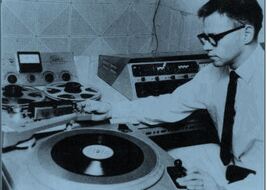 Yesterday we discussed Harry Spencer's account about the installation of generators on the mv Fredericia. Harry ran into problems with the employees of Dundalk Engineering Works who downed tools immediately they learned what the mv Fredericia would be doing. They had been told that this ship was to be a new ferry boat to revive the business that once operated out of Greenore, prior to January 1952. This is what Harry Spencer had to say about this matter. "We had some German generators to fit on the mv Caroline, I had made some suggestions where to site them, I marked out areas of steel bulkheads that would have to be cut, and marked out on the deck where the plant would be sited. I needed extra staff for this work, about half a dozen in all including engineers, welders, burners, etc., which we got from Dundalk Engineering Works. The work continued apace, but when the company discovered that this was to be a radio ship, the workers did not return." Based upon the recall of Harry Spencer, this event took place some time around February 25, 1964.
The other key dates that need to be considered are these: Wijsmuller assisted in the purchase of the Fredericia at Copenhagen, Denmark on December 30, 1963 which is when it was taken to Rotterdam. On a date prior to January 30, 1964 Harry Spencer went to 47 Dean Street to meet Allan James Crawford. On February 5. 1964, the mv Mi Amigo arrived at El Ferrol, Spain and Harry Spencer was there to inspect it. On February 13, 1964, Harry Spencer arrived at Greenore, Ireland and discovered that the mv Fredericia was already there. Based upon the recall of Harry Spencer, the installation of the generators took place some time around February 25, 1964. When George Saunders arrived at Greenore for his job interview with Alfred Nicholas Thomas, which seems to have been around the date of Friday, March 13, 1964, the mv Mi Amigo was tied up next to the mv Fredericia. On March 27, 1964 , the mv Fredericia renamed Caroline, left Greenore bound for an anchorage off the coast of Essex, England which when and where the radio ship began test broadcasts upon arrival. The Granada TV documentary which was part of the 'World in Action', that was shown on May 12, 1964, but the film crew was at Greenore after the mv Fredericia had left, because it only showed the mv Mi Amigo in port at the time, but still photographs showed that the was not much distance between them, and John Howard Gilman's initial introduction to the ship, after they arrived from Dundalk, recounts them walking past the mv Fredericia on the quay, to reach the mv Mi Amigo. According to this time scale the work and confusing confrontation regarding the generators installation by Dundalk Engineering Works, had already taken place before George Saunders arrived at Greenore. Now we come to the third person in this story, and he is a Swede named Ove Sjöström. [See picture top-right.] Ove had previously worked on the mv Mi Amigo under its name of Bon Jour when the ship was the home of Radio Nord. But later, on board the mv Caroline, ex-Fredericia, Ove made a recording for his friends in Sweden, although Ove does not give a date for his audio letter, which is in response to a tape he had received from the person he was talking to in reply. The only clue offered is when the transcribed notes say that he made it "in the Spring of 1964. but he did provide his location: "At the moment we are anchored outside Ramsey on Isle of Man at about 5 kilometers from the beach." This recording was later transcribed into English and put online, and the following quotations are excerpts from that transcript: "The studio I am sitting in just now is approximately 2x4 meters; a little studio. I am speaking about one meter from the microphone so you hear the background noise from the generators. This noise is not going out over the air that much as I have cut out the frequency band now, so that at 250 cycles it is approximate minus one dB; at 30 cycles it is minus 10.5 dB. From 500 cycles up to 15000 cycles it is within +/- 0.5 dB, so in fact it is more or less a hi-fi sound on this station and it is great to achieve that. The generators are two Mercedes diesels each of 125 hp with a switch panel from which everything is switched automatically. Not yet can we start the generators from up here, but I am preparing for this to be possible." These are the same generators that were installed by Dundalk Engineering Works on site at Greenore. Ove continues: "The working force on board is myself as chief technician plus three panel operators. .... The antenna makes it possible to go down as far as 1175 kc so we are having great possibility to move on. And if we can go down to 300 meters this also means that we are going to get a larger coverage in our ground wave, which in fact matters most to us." Translated, this means (1175 KiloHertz, or close to 256 meters, with 300 meters representing approximately 1000 KiloHertz.) Initially, Radio Caroline advertised that it was broadcasting on 199 meters, which is 1510 KiloHertz. The so-called 'merger' seems to be one of confusion for Ove, because he says that: "Around the end of August, the program will probably be changed completely, now when we have merged with Atlanta. Then all recordings will be done in London. At the moment they are building studios, four of them, to make it possible to arrange recordings from there and then they are double them off and send one copy to each ship. So we are going to broadcast the same program at the same time from both of the ships and probably all of the programming to be on tape in the future and nothing directly from the ships as it has been done up to this date." It was during this time that Chris Moore was supposed to become the 'Caroline Network' Program Director, but for mainly practical reasons that did not happen and both stations mainly used 'live' presentations from the two ships. However, from the very first day on air, Caroline's early programs from the mv Fredericia were broadcasting tapes made at Allan Crawford's studios at 47 Dean Street in London. This is something that Ove has little first hand knowledge about, because he admits this: "Unfortunately I have been very little in London at our head office .... next time I am going to London in middle of August then I shall bring home all the photos from this ship, the studios in London ...." Tomorrow this thread will continue with Ove's observations and it will be followed by George Saunders' commentary about the poor state of engineering on the mv Caroline. 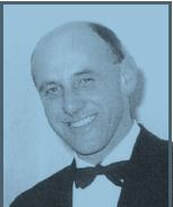 Harry Spencer, who we have referred to previously, is the person who was called by Allan James Crawford to come up from the Isle of Wight to Crawford's office and studio at 47 Dean Street. Spencer was a specialist when it came to rigging masts on ships, and in this instance he was to install two masts to support two antennas, both designed by John Howard Gilman for installation on two ships. Spencer recorded his involvement with Crawford in an Appendix to a book written by Ralph C. Humphries. In the instances where Spencer wrote from first-hand personal knowledge of an event, his recital appears to be accurate and very specific. But where he recited information that he had derived from other people, and where he had no direct knowledge, his account is both vague and contradicted by events authenticated by other means. There is more than one example of these errors in his written work. Therefore, with that caveat in mind, we draw now your attention to his own following accounts, which are based upon his first-hand knowledge: On Wednesday, February 5, 1964, Harry Spencer was at El Ferrol in Spain, awaiting the arrival of the mv Mi Amigo with Captain de Jong Lanau of Wijsmuller.
On Thursday, February 13, 1964, mv Fredericia departed Rotterdam, Holland, bound for the Isle of Wight, but then changed course for Greenore, Eire. It would appear that work on the two masts was originally going to be performed in the Isle of Wight, within the territorial waters of the United Kingdom. If so, then the switch to Greenore was a last minute decision. Did the word come down that the GPO was about to raid the ships, just as it had raided GBOK at Sheerness? Remember, paperwork exists to prove that the GPO was discussing the idea of jamming Radio Caroline when it first started up! Even the idea of boarding the ship was considered and even tried out. It should be noted that Crawford's original ship, the THV Satellite, was docked at the Isle of Wight, so the mv Fredericia was redirected to Greenore at the last moment!. Harry Spencer drove to Holyhead; took his car loaded with equipment on the ferry to Dun Laoghaire, near Dublin, Eire, and then drove on over to Greenore. When he arrived at Greenore, the mv Fredericia was already docked alongside the abandoned railway terminal. Spencer was given a cabin to stay in while he worked on the ship. While working on the mv Fredericia, he was invited to a meal with the O'Rahilly family, and Harry Spencer wrote: "Mr O'Rahilly senior was a definite republican, he was a product of the 1916 and 1922, problems and solutions. He would not speak to me, or even look at me, in fact he sat with his back to me. I could hear him ask his son, 'What's the English man saying now', or 'what is he doing?'" Spencer also wrote that: ".... the mv Mi Amigo had since arrived and the Fredericia, which had now been renamed Caroline, was nearing completion. The captain, and some of his crew, wanted a good night out, before the ship sailed, so we all went to Dublin. Plenty of alcohol was consumed, and some of the crew dallied with ladies of the night." "We had some German generators to fit on the mv Caroline, I had made some suggestions where to site them, I marked out areas of steel bulkheads that would have to be cut, and marked out on the deck where the plant would be sited." "I needed extra staff for this work, about half a dozen in all including engineers, welders, burners, etc., which we got from Dundalk Engineering Works. The work continued apace, but when the company discovered that this was to be a radio ship, the workers did not return." "Two social events took place around this time; firstly we were invited to the crane driver's house, to watch a Cassisus Clay fight ...." [As previously noted, this event took place on February 25, 1964, which was two days prior to the formation and registration of Planet Productions Limited in Dublin on February 27, 1964. At the second event, Harry Spencer wrote that he had a social evening with food and dancing:] "I then entered a conversation with a local Catholic priest who asked me how the work was progressing. I told him that we were having a problem, because the Dundalk Engineering would not allow their men to work on the ships, once they found out what they were really going to be used for." "'Well now, when would you be wanting these Dundalk men to come?', he asked." "Ideally tomorrow, but I don't think that they will be allowed to come." "'Ah well, we will see about that', he smirked.'" "The next day the workers duly arrived, such was the power of the priest, in Ireland, at that time." So there is the issue: there is the problem that caused George Saunders to be sent to fix the pending disaster on board the mv Caroline. George blamed Ove Sjöström, but it seems now that Ove was not to blame! Ronan O'Rahilly was a convenient patsy, he was not the man driving the project. That man was Charles Orr Stanley who was a Protestant Irishman with a home near Cork. That is also where REM island was being built for Radio and TV Noordzee! But it seems that this 'Radio Caroline' project was sprung on O'Rahilly Senior at the last minute - because O'Rahilly Senior was short of money! In other words, Aodogán O'Rahilly was bought off with the help of his son! Remember, Aodogán O'Rahilly was by birth an Englishman, having been born at Hove near Brighton, and he married a U.S. citizen and lived in a house built with plans bought at a New York department store! But more than this, Aodogán went to the USA with his begging bowl right after WWII, and got rewarded with money from the US Marshall Plan. This is the same man whose brother was pro-Nazi and wanted Hitler to defeat the United Kingdom! We will also be bringing you the story of George Saunders and his clash with Ove Sjöström into this mix. We will explain why Aodogán O'Rahilly begrudingly allowed his facility at Greenore to be used, and what Aodogán O'Rahilly and the rest of the O'Rahilly family did not want you to know. This theme will continue tomorrow!
 At the start of World War II, its Taoiseach Éamon de Valera, adopted a course of neo-neutrality, in that he helped the Allied cause more than he helped the Axis powers. But when Adolph Hitler took his own life, both the Irish President and De Valera caused eyebrows to raise when they signed the Nazi book of condolences in Dublin. 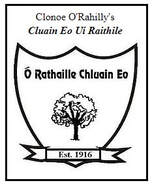 The second version of 'The O'Rahilly' gave his name to a Dundalk football club, but the third version of 'The O'Rahilly', the one who was a barrister; he openly cheered on Adolph Hitler. While Heinkel was bombing London, he hoped that the Nazi Germans would invade the United Kingdom; separate it from Northern Ireland, and then hand over the captive counties to Eire, thus uniting of all of the island of Ireland as one nation. 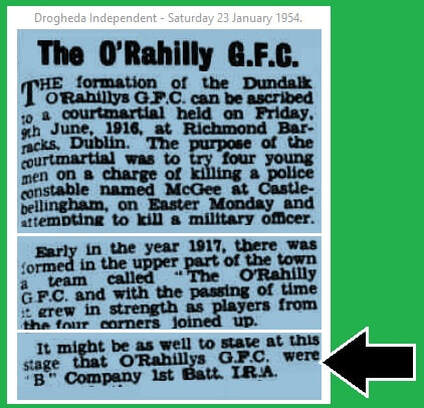 Then we move up in time to the tangled history of the Nineteen Fifties at Dundalk. 'The Drogheda Independent' for Saturday, January 23, 1954, even described their football club as being 'B' Company 1st Batt. I.R.A. The reason for juxtaposing two images of Heinkel products, is because one of their products bombed civilians in England (while the barrister also named 'The O'Rahilly' cheered them on.) The other Heinkel product was intended to rescue jobs at the Dundalk Locomotive Works! 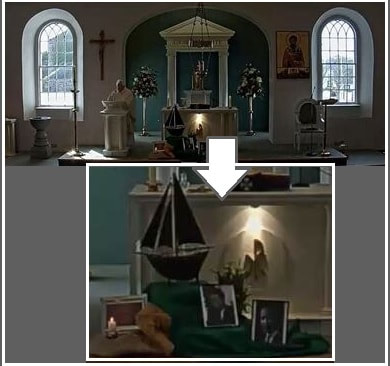 Now this is not the image of the O'Rahilly family that has been served up to the trolls who buy into the anorak version of Radio Caroline. When we get to unravelling just how the O'Rahilly family came to control the former railway property at Greenore, more shocks and surprises will await brainwashed minds. So it might be a good idea at this stage to remember just how many lies the unwitting Catholic priest was told to say about Ronan O'Rahilly. Please refer to this video which first appeared on our Blog entry for 4/23/2020.
But the only way this can be explained properly is by peeling back the layers of misinformation that have been fed from the pages of troll books, and then deceived everyone!
However, because the truth is diametrically opposed to the fake stories, and because so many questions are likely to be asked, it is necessary to reveal the side of the story that has been concealed, very slowly; one fact at a time. That is what we are doing. It is not just sloppy reporting to say that Ronan O'Rahilly's father bought Greenore railway station from British Railways, it is totally untrue. How Ronan's father acquired his financing is also an interesting story, and we will be explaining the answers to all of the questions within the episodes that follow. But in the meantime, here is a question for the trolls to ponder: If the O'Rahilly family had a history of hatred for what the English had done to the Irish over the centuries, then why on earth would Ronan's father suddenly turn around and assist a lot of English people create an English pop music station called Radio Caroline? You will discover the answers here, in editions of this Blog that will follow this one.
Ireland was by no means a united country within the Republic, and neither was the occupation of Northern Ireland the only issue. There were also religious divisions between Catholics and Protestants, and some of those issues tied back to the invasion and conquest of the British Isles by King William and his Dutch Army and the war he waged in what is now Northern Ireland. This was all papered-over as a 'Glorious Revolution', but there was nothing 'glorious' and peaceful about it. The British Crown used the same General Post Office (GPO) to rewrite history that had been used back in 1660 when its new monarchy was created following the defeat of the united republican form of government led by Oliver Cromwell. (See the video at: http://yesterdayneverhappened.com ) 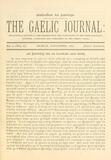 But in Ireland the nationalists added a new and distinguishing layer based upon the adoption and promotion of the Gaelic language (Athbheochan na Gaeilge), which was a movement that began in the late nineteenth-century. The promotion of an Irish language was intended to separate the people of the island of Ireland from the people of the island of Great Britain, but it was a movement that was limited in appeal and acceptance. It was from this same line of thought that journalist Michael Joseph Rahilly came to the fore, more after his death, than during his life. He was the person who also called himself 'The O'Rahilly', after a forebear who was a poet that originally invented that term. Michael, and his American wife, gave birth in England to a son named Egan John Eoin O'Sullivan, who called himself Aodogán, and another son named Richard McEllistrim Rahilly who became a barrister at law.
Richard was known as Mac to his friends, but in court he also called himself 'The O'Rahilly', just like his grandfather, and the ancestral poet before them. The roots of Mac were firmly planted in the Gaelic language of his father, and politically he had been on the side of Adolph Hitler. His hope was that Nazi Germany would defeat the United Kingdom of Great Britain and Northern Ireland, and then the Republic of Ireland could be reunited as one nation ruled from Dublin. This is where the roots of Radio Eireann are entwined with one faction who attempted to use a revised Gaelic language to separate the Irish from the English, and it also adversely worked against the the interests of three people who were in their own ways pioneers of European broadcasting. These three also had broadcasting interests in Ireland during the Nineteen Fifties, and their interests came face-to-face with the Gaelic movement, and they lost out to it. These three people are: Charles Orr Stanley, Chairman of the Pye Group of companies and a Protestant Irishman with his own roots in a home near Cork, Eire; Gordon McLendon of Dallas, Texas, whose company was the owner of the mv Mi Amigo, and Charles Michelson, who was the creator of Radio Tangier International; Radio Europe I, and Radio Monte Carlo. Further details about these three men and their involvement with offshore broadcasting, will appear later. Tomorrow we will look at what happened to the facilities at Greenore. 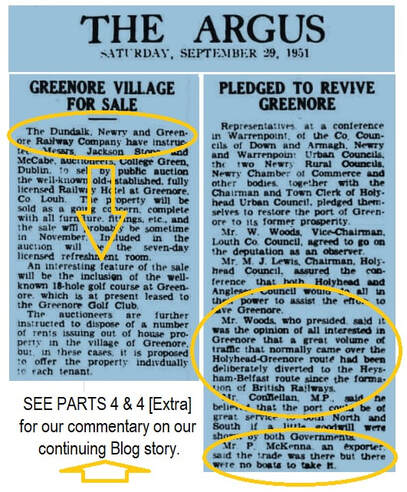 The story (shown right), reflects the actual situation at Greenore on September 29, 1951. The Seller was the Dundalk, Newry and Greenore Company, which came under the ownership of LMS which was represented in the Republic of Ireland by Great Northern Railway (Ireland) company, (GNRI). When the British half of these railway interests were nationalized in 1947 and then brought under the banner of British Railways (BR), the British half of this contract pulled out of the agreement which included the Dundalk Locomotive Works. So while the Dundalk Locomotive Works immediately became an industrial and political problem that resulted in the stop-gap creation of the Great Northern Railway Board (GNRB) which was jointly owned by both the Irish and British governments, the Greenore property was simply dumped on to the open market. The GNRB had its hands full of problems at Dundalk with all of the about-to-be employees deprived of a job with income, and GNRB's attempt to resolve their immediate situation was not very successful. But Greenore was now a property deprived of any population, save for the few who lived in houses adjacent to the golf course; hotel and railway station which were all a part of one property that had been turned over to Messrs. Jackson Stops and McCabe; a Dublin firm of auctioneers. 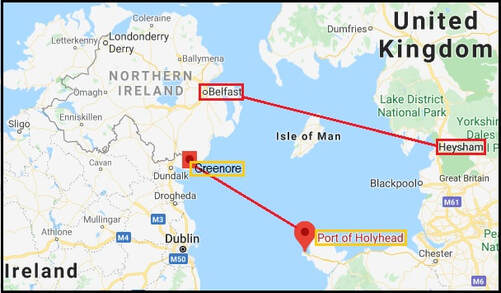 Although there was no population left in Greenore to really cause problems, unlike Dundalk, the local Irish government officials did engage in a blame game. (See the news story above.) Clearly no one was going to worry about the houses; golf course and railway station, but the ferry service was another matter. But again, we need to recall that back in 1940 the passenger service was terminated and all that was left was a once-a-week freight (cargo) service going by sea from Greenore in the Republic of Ireland to Holyhead in the United Kingdom which originated from the island of Great Britain, and not from Ireland. That once-a-week ship which had sailed since 1940 from Holyhead in Great Britain, in 1947 came under the ultimate control of British Railways (BR) after nationalization, and so BR switched its inherited connection points from Holyhead on the island of Anglesey (Wales); to Heysham in Northern England, and then it made another new connection to Belfast in Northern Ireland. This gave the nationalized industry which was owned by the British Crown corporation sole known as the United Kingdom of Great Britain and Northern Ireland, two connection points within its own jurisdiction. Clearly this had also helped to inspire the derogatory editorial against nationalization, which had appeared on the same page of the same issue of The Argus newspaper, as two stories relating to Greenore and its demise. See Part 4 [Extra] for details. This move had then prompted one MP in 1951, to suggest that Greenore could be saved by a little goodwill by both governments in order to assist Irish exporters to England. But, the story noted, there were no boats available, and then there was still the issue of World War II which had only ended six years earlier, and during which the Republic of Ireland had declared itself to be a neutral nation during the conflict. So goodwill which had been lacking back then, was in 1951 still no where in sight. Something else to be considered: The 'boats' that were "not available" were British 'boats'! Not Irish 'boats'. 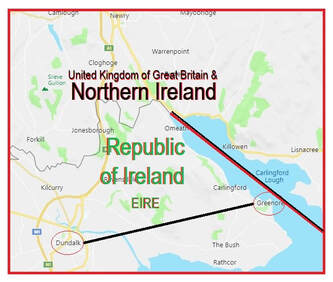 Now look again at the geographical location of Greenore. It sits just across the divided waters of Carlingford Lough from Northern Ireland. Its former rail link north to Neary was now inside Northern Ireland. The roads going to the peninsula on which Greenore is situated, were poorly maintained and not conducive to heavy freight traffic. In short: who would want it? In an attempt to discover the answer to that question, the matter was turned over to a firm of auctioneers in Dublin who were instructed to sell the property in any way possible. This also led to the entire matter being given a public airing prior to auction, which is reflected in the two news items that appeared in The Argus newspaper for Saturday, September 29, 1951. More about the auction, tomorrow. A comment recently posted on another Forum has been brought to our attention concerning the practice of this Blog in seeming to 'jump' from one topic to another (in the immediate instance it was in reference to rail and port issues.)
Please note that this seemingly disconnected approach is intentional. It is used in order not to take one topic too far forward of a current theme, and at some point all temporarily halted topics will be continued within the time frame, and thus joined up to complete a unified story. Eventually the contents of this Blog will be converted into an episodic book format within chapters. Similarly, an academic book format will be used to assemble all of the previously published data into a text book format. The Blog coverage provides an overview of 'content within context' of researched information which is related to our series of academic monologues at http://foundthreads.com A blog format allows for the wide canvass of information relating to a theme within past events to be re-examined in microscopic detail. Consequently this Blog does not read like a book, nor do the articles necessarily continue from one day to the next day's entry, although they may do so. They often begin, and then halt while other issues are addressed and brought up to that same point in time. This work of public education in the public interest in Blog and monologue format is provided at no charge to the public. The authors have no political, religious or commercial objective governing their research. The governing theme behind this research project is that of individualism versus collectivism. It is based upon the fact that all human beings are temporal, and none have Supreme Insight into the purpose of human life itself, and therefore no human being has a legitimate claim to acting for or on behalf of any Originating Force responsible for all existence. Today's continuing Blog entry [Sabotage from Dundalk, part 4 and a part 4 [Extra]], have been posted, and so this is a bonus that we had to include because it is what happens to liars when they refuse to admit the truth and continue to lie. They simply post this kind of nonsense:
"Posted by Paul Rusling on July 21, 2020, 9:56 pm, in reply to "Re: Freedom of speech - Its not only freedom of speech that important, its being free of those who try to stop it, and who lie so openly. I don't understand why some odd-bods would want to remove things from history, and add their own irrelevant smokescreen to the story. Is it for some self grandeoisment? And why others should continue entertaining those 'history muddiers and modifiers' is quite beyond me. I find it best to steer clear of them. Life seems to be a long lesson, with every person I ask offering their own variation of the story. Most are just mildly off the track, some seem to make stuff up, and then there is the old fool who wants to rewrite the whole tale (and remove the key man!). The reason for putting assets into foreign trusts is to prevent the veil of incorporation being lifted. Its not cheap setting up anstalts, etc, and using them to trade, but sometimes its necessary to do so. Idle and vexatious fingers ferreting around are then little more than a nuisance. Those who ran the money out to them and administered other bits of the operation are dismayed there should be attempts to unravel the carefully constructed networks and to besmirch people who helped develop our radio and free it from the tyranny of the state. Its bemusing to ponder what the motive could be for such nastiness and a waste of time. The Radio Caroline bible simply collects the various stories together, sieves out those that fit together and relates them in a coherent manner, without the boring and irrelevant clap-trap. I'm so grateful to the guys and the ladies who I persuaded to share their memories and pictures." There is the reaffirmation of what Paul Rusling told us in person: Now he has restated it for all to read, and so we wanted to share it with you. Rusling has no time and no interest in research. What Rusling now tries to defend is the mythology that he has cobbled together under the audacious claim of being a "bible", but it just won't stand up to examination for accuracy. So Rusling responds by castigating all investigative journalists, and all educational researchers who try to uncover a true account of the past versus political; religious, and commercial propaganda. To those who find value in educational research, it is not as Rusling claims: "irrelevant clap-trap". but his "bible" that, he writes: "simply collects the various stories together, sieves out those that fit together and relates them in a coherent manner ...." comes straight out of the Nazi text book of Joseph Goebbels, and the dictatorship manuals of Joseph Stalin; Chairman Mao and a host of other jumped-up idiots who start both wars and create extermination camps for those they hate. Somewhere along the line, even the most brainwashed of anorak trolls must soon realize that people like Rusling have played them for fools and taken money from them under false pretenses. Or are these cult-like followers so afraid of the truth that they do not see or read the daily exposure of people like Rusling, as nothing more than empty self-serving frauds? 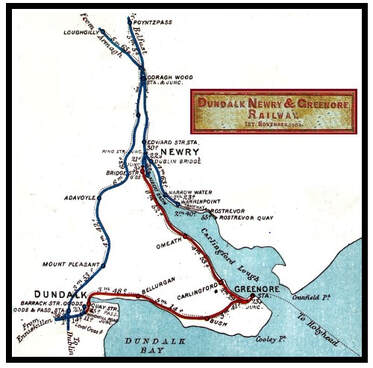 The story of the rail lines and the related ferry service that once connected Greenore to the rest of Ireland and then the outside world, is far from straightforward. Because our own interest in these rail lines in peripheral to the overall subject matter of this Blog, we have turned to others who specialize in such information for our own enlightenment. One such site is John Speller's Web Pages about the Irish Railways. See: https://spellerweb.net/rhindex/Ireland/Dundalk.html The story of behind the rail and ferry services centered on Greenore, began in 1867 with the London and North Western Railway (LNWR) which operated a rail-head at Holyhead in Anglesea, with rail links across the island of Great Britain, selecting the fishing port of Greenore to build a new harbor; a pier; a modern hotel, and a railway station terminal and railway line that connected to the town of Newry to the north of Greenore. Adjacent to the rail-head the company also built a modern hotel, and in the surrounding area, it encouraged the start of a small town with street names such as Anglesea Terrace and Euston Street; together with another area devoted to extensive cattle pens. Three years later in 1873 a ten mile stretch of track was opened to link Greenore with Dundalk to its south-west. When the majority of the island of Ireland gained independence in 1922, the LNWR was swallowed up by a new London, Midland and Scottish Railway (LMS) company. In 1927, with the ports of Belfast and Dublin having direct access to large population centers, the passenger ferry service to Greenore, was withdrawn. In 1933, LMS signed an agreement with the Great Northern Railway (Ireland) company, (GNRI) to manage its affairs in the Republic of Ireland. GNRI became an international oddity, because this one railway company had a cross-border service linking both the Republic of Ireland with its Irish rump designated as Northern Ireland. While the majority of the island was controlled by a legislature in Dublin, the rest of the island was still under the control of the British Crown corporation sole based in London, England. Then came World War II and the Republic of Ireland decided to remain neutral. The Greenore passenger ferry service had already stopped back in 1927, and now all freight shipments by sea from Greenore were reduced in 1940 to once a week. Because all of the GNRI locomotives were still being serviced in Dundalk at its Locomotive Works, that facility was governed by a cross-border consortium of business interests. 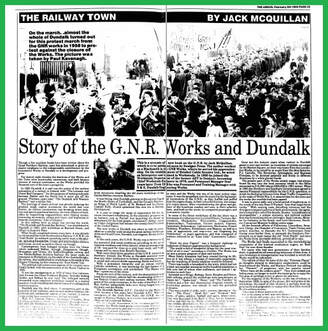 "For almost eight decades the destinies of the Works and the Town were inextricably interwoven, and both became sources of sources of mutual sustenance, as the Works provided the core for the town's prosperity." "It was the amalgamation in 1876 of .... four railways, that formed the Great Northern Railway formally linking Dublin and Belfast by iron road. The enlarged network demanded more extensive workshops located in a central position for the building and maintenance of its rolling stock and locomotives." The quotations above have come from a feature on pages 24-25 of The Argus, and dated February 5, 1993. The original source material is based upon a book about GNR by Jack McQuillan. Due to increased competition from road and air transport between the two Irish nations, in 1947, GNR introduced a non-stop service between Dublin and Belfast, but it was not profitable. The following year on January 1, 1948, the Great Western Railway (GWR); London, Midland & Scottish Railway (LMS); London & North Eastern Railway (LNER), and Southern Railway (SR), were all swallowed up in a post-WWII act of socialized nationalization of rail and road transportation governed by the British Crown via its Parliament in London, and consequently the formation of British Railways absorbed the LMS-GNRI contract. In 1951, the Northern Ireland interests of British Railways in the Dundalk Locomotive Works were terminated almost over night, and almost immediately 1,200 employees at the Dundee Locomotive Works were given one week's notice before their jobs vanished. 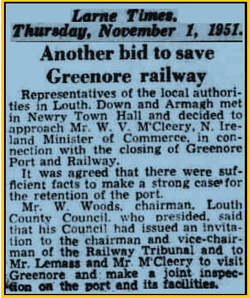 Meanwhile, in 1951 over in Greenore, the trains stopped running and its once-a-week cargo shipments were also brought to an end. Remember, the passenger ferry service ended in 1940, and so the entire property of the railway company at Greenore was allowed to fall into a state of disrepair. Sitting on a peninsula, Greenore was not a part of any major population center, and therefore it did not retain any commercial value for business interests. Back in Dundalk a political storm erupted, and both Irish governments agreed to subsidize the Dundalk Locomotive Works which at that time was still a private company. But by the end of 1952, with the company drowning in debt, the two governments agreed to create the Great Northern Railway Board (GNRB) and take over the remaining assets and debts of the former private company. "It was to prove sadly only a brief period of euphoria .... 'Into that magic burst reality' .... With the soaring costs, dwindling revenues and the divergent transport policies of both governments, the agreement toward the end of the decade became a 'misalliance of incompatibles'. a unique economic and political cocktail that was fermenting into an imbroglio ...." which is defined as an "extremely confused, complicated, or embarrassing situation". So in 1958 the GNRB was also killed-off and its assets were then divided between Northern Ireland's Ulster Transport Authority and Eire's Córas Iompar Éireann. Although these two bodies had already terminated most of the rail services of the former GNRI network; they did not close the Dublin to Belfast line.
That is when the Irish government helped to establish Dundalk Engineering Works and other companies which included Heinkel Cabin Scooters Ltd.
But even this remedy was not to last. To find out what happened next, please check in tomorrow!  In 1960, George Saunders has stated that he began his first job with the Marconi company in Chelmsford, just after leaving school. George does not seem to have told anyone a lot of very specific information about himself. Possibly that is our fault and the fault of others who have interviewed him over the years. But until recently this did not seem to be a matter of any great interest. It is now! Along with Howard Spencer, who we have mentioned before and shall do so again very shortly, George Saunders helps us to narrow-down a timeline of events, which no one else appears to have even attempted to do, because the significance of such a timeline did not dawn on them and until very recently, it did now dawn on us, either. First of all we would like to know the actual date when he began his employment with Marconi. Then we would like to know the actual date when he first met John Howard Gilman in a pub at Chelmsford, Essex. After that, we would like to know when he actually gave his notice to quit his job at Marconi, and finally, the actual date that when he first board the mv Mi Amigo to begin his employment when the ship was anchored off Essex and broadcasting under the name of Radio Atlanta. Perhaps some of our readers can fill in these blanks for us? 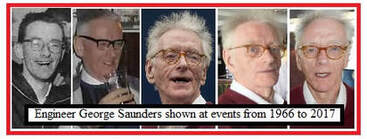 What we have been able to deduce [see our blog entry for June 30], and based upon all of the evidence that is available to us from a variety of sources, including various recollections by George Saunders himself; we have concluded that he must have stepped off the train from Dublin and on to the Dundalk railway platform sometime after finishing work for the day at Marconi, and his weekend began. If he left work for that week on a Friday evening, and then he immediately departed for Greenore via Dublin; then the date was probably March 13, 1964. Because sunset on that day was at 5:59 PM, and depending upon the actual time that he finished work, most of his journey would have been during darkness, meaning that it would have been a late start on such a journey that he had not undertaken before. However, given that he had to go from Chelmsford, Essex to the airport (probably Heathrow), and then catch a flight to Dublin after which he had to go the Dublin railway station, and then catch a train bound for Belfast from which he was to alight at Dundalk; it is more likely that he arrived on the Dundalk railway platform at some time during the morning of Saturday, March 14, 1964. It is therefore likely that George Saunders stayed at Greenore, until Sunday, March 15, 1964, and we add that note since George is a prudent man, and therefore it seems highly unlikely that he would have quit his job at Marconi, without first obtaining the guarantee of a new job. However, there is another caveat to consider, and that is before he got to Greenore and had a final interview with Alfred Nicholas Thomas on board the mv Mi Amigo docked at Greenore, he did not know for sure that he had the offer of a new job. Therefore we will use the date of Saturday, March 14, 1964 as our baseline from which to build out a timeline which first reverses back in time, and then goes forwards to establish other dates in context. The only way that this dateline could be in error, is if some parts of George Saunders' related story are untrue; but since he has more-or-less told the same story consistently to several people without conflicting information, we have to accept the date of Saturday, March 14, 1964 as being our baseline. Now while there certainly are gaps in the story as told by George Saunders, but there are no conflicting dates of which we are presently aware. 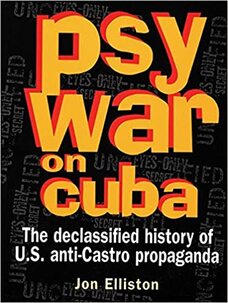 It may, or it may not be a matter of significance that George Saunders does not appear to have made any mention of this event, which received extensive worldwide coverage on both radio and television news bulletins. Because many people in Ireland had both a picture of the Pope and a picture of the slain President hanging on a wall in their homes, and many who were alive at the time remember exactly where they were and what they were doing when JFK was murdered in Dallas, Texas. Therefore, anything to do with his death was being noted and discussed in general conversation, especially in Ireland. Although the guilty verdict handed down against Jack Ruby was later overturned on appeal, Ruby died of cancer before a new trial could take place. But if George had noted where he was when that verdict was handed down, then it would have enabled us to fix a date stamp upon his visit to Greenore. In case you are wondering whether George Saunders was remotely interested in the circumstances surrounding the death of John F. Kennedy, or what any of this has to do with the radio ship at Greenore that he was going to visit and perhaps get a new job, then you should consider the following information provided by George Saunders. Several years ago, Chris Edwards interviewed George Saunders for Offshore Echos magazine, and this is part of the transcript that transpired: Edwards: "Do you know much of the previous history of the Mi Amigo, it was certainly used on Radio Nord. Gordon McLendon had quite an involvement with it. There is the possibility it may have broadcast to Cuba." Saunders: "Now I can tell you a bit about that. Something I came across, the CIA looked at it and this is when it was owned by the two Texas oil millionaires, Thompson and the other chap. What the CIA wanted it for, not as a radio ship at all, they wanted to launch small balloons, carrying propaganda into Cuba. This was the idea and somehow of course it didn’t happen. But I’ve come across the memo concerned in a book called Psychological Warfare on Cuba and it's a collection of documents as published a few years back." We have also spoken repeatedly to George Saunders, and he prompted us to buy the book that he referred to and is illustrated above. The "collection of documents" mentioned by George Saunders are actually declassified Central Intelligence Agency documents that form the basis for the book. There is a reference in one of the documents to a CIA 'Operation Mongoose' meeting that was chaired by the brother of John F. Kennedy. Robert F. Kennedy was wearing two hats. One of them was a visible and nepotistic post as Attorney General of the United States of America. His other hat was invisible to the hoi polloi. More about that 'other hat' in a moment. The "Thompson" referred to by George Saunders, is one one a trio composed of Gordon McLendon; Clint Murchison Jr., and Robert F. Thompson. It was Thompson who had senior management control of the ship that was renamed Mi Amigo. 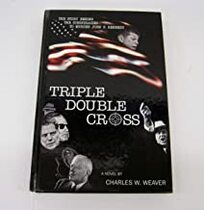 Thompson's own manager was Charles W. Weaver with whom we have had personal contact, and we still maintain contact to this day with both his widow and daughter. Before Weaver died he wrote a series of manuscripts, and one of them which appears to have been influenced by a ghostwriter after Weaver's death, does not make a lot of sense. But earlier versions of his unpublished manuscripts - some of which we already have - tell an interesting story with some degree of verified credibility. We were about to receive the entire his file just prior to the Virus pandemic making travel difficult. 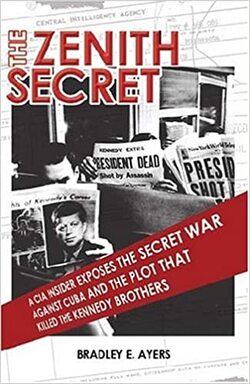 Part of the Bobby Kennedy plan called for Thompson to bring the Mi Amigo to Galveston island in the Gulf of Mexico where it would be stripped of all broadcasting equipment, and then outfitted with helium balloons. The balloons would be filled on deck with gas and then they would hoist attached propaganda packages high into the sky to be blown over Cuba. Once on station over Cuba, these packages would then be released. Bobby Kennedy was actually running a secret faction of Central Intelligence Agency assets that were based on the southern campus of the University of Miami. His brother JFK, had promised the world that there would be no more invasions of Cuba by the USA. In one sense he sort-of told the truth, but in legal parlance he was lying through his teeth! The mercenary army managed by Robert F. Kennedy, was headed by a Cuban ex-pat and his troops were shipped off shore to countries in Central America, although their banking was still controlled in Miami. So in one sense the USA was not performing any hostile acts via its own people, but indirectly it was financing and facilitating a huge anti-Castro operation. Because of the start of the 'Cuban Missile Crisis' in September 1962, the Mi Amigo (still called Magda Maria at that time), could not leave European waters and cross the Atlantic Ocean because the U.S. Navy was blocking all sea lanes: including those leading to Galveston in the Gulf of Mexico. Mainly for that reason the larger mv Olga Patricia was used in its place. This same CIA ship was later brought to the UK as the home for two more offshore radio stations which were also financed by Texans: Radio England and Britain Radio. On Saturday, March 14, 1964 as George Saunders got off the train at Dundalk, the mv Mi Amigo had secretly slipped out of port on Galveston island, just after the murders of both John F. Kennedy and Lee Harvey Oswald. Now it was tied-up at the waterfront of the disused railway terminus and ferry port at Greenore, located just across the water from the British rump nation called Northern Ireland.
Because the history of how that railway terminus fell into disuse and then came under the control of Ronan O'Rahilly's father, is a segment all by itself. That will be left for explanation until tomorrow's entry in this Blog. [NOTE: This text was both revised and expanded in detail on July 22, 2020.] We were just asked (again) on the Comments Forum, why this Blog is delving so far back in time and in so much detail, so this response for everyone to read has been injected into the regular blog entries. (The continuation of yesterday's Blog entry will appear here tomorrow).
"In answer to your question, you should go back and read the opening of the blog for 7/17/2020. It has been addressed several times. The more specific that this Blog becomes the more obvious that the reason why the story of Radio Caroline has never been told, is because it has been addressed as an ENGLISH - meaning ENGLAND - story, which it is not. It is first and foremost an IRISH story with a LOT of AMERICAN influences going all the way back into the history of the O'Rahilly family and bringing in the visit to Ireland in 1963 by JFK and his ASSASSINATION. It is also about the AMERICAN broadcasting influences involving the ship that became known as Mi Amigo, and the HIDDEN geopolitical antics of Allan Crawford. Now add to that the HIDDEN history of the United Kingdom and its tie to Constantine; the Roman Empire; Herbert W. Armstrong, etc., etc., and we have not even begun to address the untrue claim that there was no pop music on the British airwaves before Caroline. The Beatles' claim to fame PRIOR to Caroline puts paid to that lie. I know that some anorak writers have IRISH backgrounds, but they came into the story very, very late. Then there are the writers with ENGLISH bias and ENGLISH writers with a total hate for educational material - such as Paul Alexander Rusling who has done more HARM to this true version of this story than anyone of late, and all of it so that he could line his own pockets with money at the expense of fools who bought his book believing it to be true. We bought it because we buy every book on this subject! Everything we write and publish has been well researched and authenticated by peer review in many instances. As it says on the masthead, this story is not about the 'Swinging Sixties' and similar nonsense. This is also NOT a book (to be) for anoraks. If they ever read it - they will be shocked into wetting their pants wondering how they could have been conned for so long. That is not difficult. Most wars, including WWII began over misinformation and WWII began with a Nazi lie about a Polish radio station. The Caroline lie is about unveiling the true story of IRISH OPPRESSION. You can talk about BLM, but BLM begins with the same source: that CROWN CORPORATION SOLE BASED IN LONDON that is built upon the lie about the 'Donation of Constantine'. I hope that this answers your question as to why it is necessary to go back in time and explain it all in courtroom-style detail to shut up the trolls and the political schemers who control the BRITISH CROWN corporation sole. And we have not YET begun on the Kennedy Assassination part or the involvement of the Mafia .... but we will." 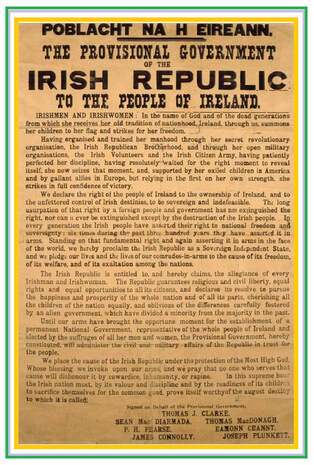 It is fitting that the Rising of 1916 took place at the General Post Office in Dublin, because that is where Ireland's broadcasting service began. It is also the name of the institution by which the Crown of England began censorship back in the year 1660. That is when General George Monck formally terminated the Republic on the island of Great Britain. The hoi polloi were forbidden to discuss what had taken place prior to 1660 under penalty spelled out in the 'Act of Oblivion'. [See the video at: http://radiocaroline.info ]. General Monck facilitated the creation of two new monarchies under King Charles II who governed his newly separated kingdoms of England; Scotland and Ireland. In 1801, the puppet Parliament of Ireland followed the lead of the Parliament in Scotland which in 1707 abdicated control by turning over its own parliamentary powers to London, and so the Parliament in Ireland abolished itself. In 1801 the Crown corporation sole based in London, pronounced the commencement of the United Kingdom of (the island of) Great Britain (England plus Wales; with Scotland), and (the island of) Ireland under the 'Act of Union' which was rubber-stamped by the puppet Parliament in London, England. In fairly recent times Egan John Eoin O'Sullivan O'Rahilly who renamed himself as Aodogán, and is the father of Ronan O'Rahilly, has been embellishing the name of a journalist who went under the byline of 'The O'Rahilly', so that someone might conclude that he was one of the main leaders of the 1916 Rising announced at the headquarters of the General Post Office in Dublin, Ireland. But there above (left), is a copy of that Proclamation, and those are the names of the leaders printed underneath. There is no mention of Michael Joseph Rahilly who later called himself "Rathaile" and "Ua Rathaille" and "The O'Rahilly", but which is not to suggest that he was not one of the leaders of the Rising. However, there has been a singling-out of Michael Joseph Rahilly to the point where his actual life and times have now begun to be submerged in a new kind of mythology. Well, now we can understand what was going on in Ronan O'Rahilly's head! It turns out Ronan's fondness for stealing bits and pieces from the lives of other people was somewhat of a tradition with his grandfather, "The O'Rahilly". We hope that the trolls who are so opposed to us exposing the truth about Ronan O'Rahilly are paying attention! Anyway, before Michael Joseph Rahilly decided to become a journalist for a Gaelic newspaper and call himself "The O'Rahilly", and before William Butler Yeats decided to pen a poem about Michael Joseph Rahilly and publish it in the year 1938, there was a doppleganger lurking in the grave for Michael Joseph Rahilly to copy, which no doubt is how his grandson Ronan then got the same idea! Thanks to 'A Commentary on the Autobiographies of W.B. Yeats', by Gretchen L. Schwenker who published her thesis for a PhD Degree from the University of Stirling in October 1980, we learn the following on page 257 and reference p.217 : "O'Rahilly - Egan O'Rahilly or Aodhagan 6 Rathaille (1670-c. 1726). A Gaelic poet, O'Rahilly was born in Sliabh Luacra, near Killarney, County Kerry. He may have studied at Killarney in a school which was both classical and Gaelic. O'Rahilly was known for his laments about the demise of the Gaelic order. He was equally famous for his satires on the new planters. Pädraig Ua Duinnin edited O'Rahilly's poetry for the Irish Texts Society (London, 1900). The poet is buried in Muckross Abbey, outside Killarney." (See: https://dspace.stir.ac.uk/bitstream/1893/12291/1/Schwenker-thesis-vol1.pdf ) Who knew? Not the anorak trolls, so it seems, and certainly not Paul Alexander Rusling who couldn't even get Yeats' name right. On page 39 of his "Bible", this sloppy plagiarist noted that: "Keats wrote a poem about him, The O'Rahilly." But then Rusling also attributed actions by John Howard Gilman to Alfred Nicholas Thomas, and insisted on telling his readers that Charles Edward Ross was known as "Jimmy Ross" in order to support the tired-old myth that a "Jimmy Ross" had financed Radio Caroline. Worse still, the present-day aging anorak community is still promoting Rusling's rubbish which is enabling him to still sell his book of fiction to gullible fools. All Rusling had to do was turn to Mark Humphrys' Online collection of wonderfully documented and illustrated authentic genealogy to learn more about Aodhagán Ó Rathaille. He is hailed as the father of the aisling poets, which is a political form of dream-like writing that employs a quasi-human female form to tell its story. Aodhagán Ó Rathaille "came to manhood as the Jacobite cause was defeated at the Boyne, Aughrim and Limerick, and wandered through Munster visiting the homes of the last of the Gaelic chiefs, lamenting the decay of the old order". See Mark Humphrys' genealogy at: https://humphrysfamilytree.com/ORahilly/poet.html Now let us zip down to 1938, and review exactly what William Butler Yeats (not Keats), had to say in poetic form about Ronan's grandfather. He is the person who plagarized his ancestor, or it could be said, draped himself in that person's garb in order to carry on the Gaelic fight against the English: 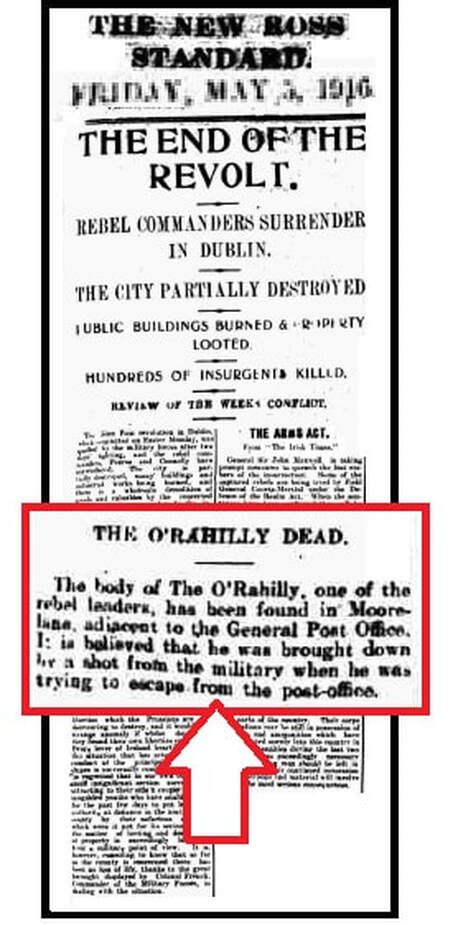 SING of the O'Rahilly, Do not deny his right; Sing a 'the' before his name; Allow that he, despite All those learned historians, Established it for good; He wrote out that word himself, He christened himself with blood. How goes the weather? Sing of the O'Rahilly That had such little sense He told Pearse and Connolly He'd gone to great expense Keeping all the Kerry men Out of that crazy fight; That he might be there himself Had travelled half the night. How goes the weather? 'Am I such a craven that I should not get the word But for what some travelling man Had heard I had not heard?' Then on Pearse and Connolly He fixed a bitter look: 'Because I helped to wind the clock I come to hear it strike.' How goes the weather? What remains to sing about But of the death he met Stretched under a doorway Somewhere off Henry Street; They that found him found upon The door above his head 'Here died the O'Rahilly. R.I.P.' writ in blood. How goes the weather? When young George Saunders who had but a handful of years working for Marconi under his belt that included his latest boring assignment of technical writer, stepped off a train from Dublin at Dundalk station; little did he know that he had stepped into a community that hated everything that his birth place represented.
He was met by John Howard Gilman, an old hand at political intrigue who was many years the senior of George. Gilman was taking George to his final, and George later recalled it as his most thorough interview, by another old-timer named Alfred Nicholas Thomas who had already been involved in a string of failed offshore radio ventures. The venue for this interview was at Greenore, which was later described by George as one the creepiest places he had ever visited. More about George and his experiences, tomorrow. 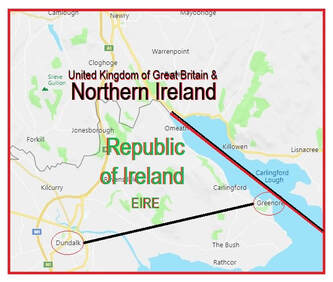 Now that you know how the Crown corporation sole based in London, England, got control of the island of Ireland, and then pronounced it to be a separate kingdom under its control, and then joined that Kingdom of Ireland to the United Kingdom of Great Britain, only to be followed by several rounds of civil war attempting liberation; we come to that moment in 1964 when former Marconi engineer George Saunders arrived at Dundalk railway station. Both George Saunders and John Howard Gilman who met him off the train, are Englishmen, and for many Irish people they represented the oppressor nation of occupation. Their destination by car and over winding roads, was to the almost deserted and disused railway station and its hotel at Greenore, which is situated on the banks of the Carlingford Lough whose waters are divided in two between the Republic and Northern Ireland. John Howard Gilman was many years senior to George Saunders, and aside from his longevity of employment by the British Broadcasting Corporation, he also had an adventuresome back story that involved shutting down the last super-power transmitter used by Nazi Germany to broadcast the propaganda messages of 'Lord Haw Haw' (William Joyce) who was an Irish-American executed at the end of WWII by the British Crown. In early 1964, Gilman and Saunders were on the same Irish soil where Gordon McLendon; Charles Michelson, and Charles Orr Stanley had recently been attempting to persuade the Irish government to award them with a contract to build a commercial television system, and an international commercial radio station. They were not successful. These three powerful advocates of commercial radio broadcasting had been up against the same forces behind the creation of Radio Eireann. It was a station of limited appeal because it was tied to the same forces behind the publication of the Gaelic newspaper that Michael Joseph Rahilly worked for as its assistant editor. He is the person who began using the byline 'The O'Rahilly', and he is also the father of Egan John Eoin O'Sullivan O'Rahilly who renamed himself as Aodogán, and is the father of Ronan O'Rahilly. Not only did Michael Joseph Rahilly die after being shot by a British gun during the unsuccessful Rising of 1916, but the territory into which Gilman and Sauders were entering, was laced with Irish citizens who shared similar ideas to Richard McEllistrim Rahilly who is the brother of Aodogán, who is the father of Ronan. Remember, Richard is the one who was known as Mac, but in court as a barrister, he also called himself 'The O'Rahilly'. The roots of Mac were firmly planted in the Gaelic language of his father, because Gaelic was not English and it helped to distinguish the Irish from that hated band of oppressive people with its capital in London, England. Mac had been on the side of Adolph Hitler hoping that Nazi Germany would cause the defeat of the hated United Kingdom of Great Britain and Northern Ireland. How do we know this? Because his brother, Aodogán, the father of Ronan told everyone who would listen! For his part, Aodogán, the father of Ronan, demonstrated the same core belief to the English who came calling about Radio Caroline. I state, and restate all of this now, within context, in order to explain how the enterprise that Gilman was inviting Saunders to join. It would later come back to haunt both of them. The problem, whose origin they did not seem to understand, would later manifest itself on board the mv Caroline. We now know why this problem came about as a result of sabotage, and we will continue to explain it all tomorrow. 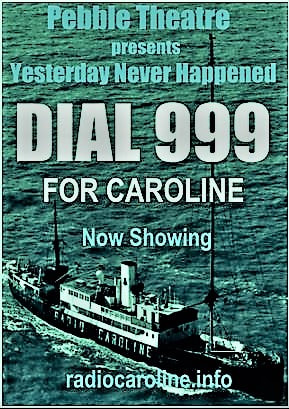 Because so much rubbish has been written not only about Radio Caroline, but the people alleged to have been behind its creation, trying to explain in a few words what really happened is an impossibility. We began attempting such an explanation in video format which is still available Online [see details right]. In that attempt we began with the words of Ronan O'Rahilly and began to work backwards through time, but this does not begin to explain the tangled web of nonsense that surrounds the entire subject. For instance, we referenced in the July 15, 2020 of this Blog, that more than one person had called themselves 'The O'Rahilly'. The illustration we used was one of many such references to the son of Michael Joseph Rahilly. It is Michael Joseph Rahilly who was began using the byline 'The O'Rahilly' while working as assistant editor of the Irish nationalist newspaper 'An Claidheamh Soluis' ('Sword of Light'); which Was a newspaper published by the Gaelic League, In addition to his son Egan John Eoin O'Sullivan O'Rahilly who renamed himself as Aodogán, and who was in turn the father of Ronan O'Rahilly, Michael Joseph Rahilly also had a son who called himself 'The O'Rahilly', but he was not a journalist, he was a lawyer. According to the genealogical research of Mark Humphrys, the Rahilly Family became the O'Rahilly family sometime after 1900. The first of Michael Joseph's offspring died at a very early age with the surname of Rahilly, and next in line before Aodogán, was Richard McEllistrim Rahilly, and this is the person who became a lawyer and also decided to call himself 'The O'Rahilly'. It seems that sometime after the birth of Richard McEllistrim Rahilly, his father decided to name his next son O'Rahilly, and thus Egan John Eoin O'Sullivan O'Rahilly came on the scene but complicated matters yet again by calling himself Aodogán. He is the father of Ronan O'Rahilly. Now let's go back and look at the life of Richard McEllistrim Rahilly. He who was born in 1903, and in 1932 he became a practicing barrister. In the Irish press during reported court cases, he was constantly referred to as 'The O'Rahilly'. But Ronan's father was not at all happy with his sibling sharing that identity, and so he began to build up his father as the authentic version of 'The O'Rahilly'. This is very complicated, and if you read this Blog when I first put today's edition on line, I later realized that my genealogy references were as clear as mud! So I have written parts of it. Now it is with Richard who everyone called 'Mac' when he was not being referred to as 'The O'Rahilly', that parallel problems that developed at Dundalk which impacted both George Saunders and Ove , find common roots in the hatred by some in Ireland for all things English. Part of that hate showed up in World War II. While the Republic of Ireland was nominally neutral, barrister Richard McEllistrim Rahilly was not neutral at all. Again, citing the excellent work on the Mark Humphrys' site, we make reference to his page at: https://humphrysfamilytree.com/ORahilly/mac.html When the UK declared war on Nazi Germany in 1939, Richard McEllistrim Rahilly decided to support Adolph Hitler in his fight with Neville Chamberlain. Mark Humphrys' quotes Mac's brother Aodogán (Ronan's father) as saying: ""Mac was a great enthusiast for the Germans." Mac's reasoning seems to have been that If Hitler could defeat the UK, then Ireland could free itself from Britain and unite as one island nation. Mac's brother-in-law who was also a senior official in the Irish Republican Army, worked with Nazi Germany on a IRA plan for the Nazi invasion of Northern Ireland. Since Hitler lost the War, and then the Nazi atrocities began to be broadcast, the pro-German sentimentality of Mac and his friends was abandoned, but their hate for all things English did not go away. That clock of Irish hatred for all things English began ticking in 1531, which was when King Henry VIII of England broke with Rome and declared that he was the 'Supreme Head of the Church of England'. In 1542, Henry VIII also declared himself King of Ireland and began his own formal enslavement and oppression of the Irish people. But worse was to follow when Henry VIII broke with Rome, because he also adopted for his own use, a major part of Rome's mythology and then draped himself in it. This is the affair that has become known as 'Donation of Constantine'. Now before you yawn and wonder what this has to do with the topic at hand, you will soon discover that a hoax that began after circa. 306, when the Roman Emperor died, resulted in his son Constantine being acclaimed Emperor by the Army based at York, England, and this in turn led to a series of myths that in 2020 still form the foundational basis for governance of the United Kingdom! It is a weird story! 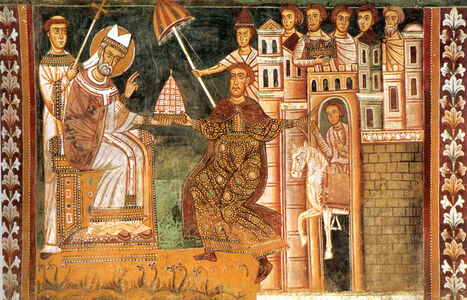 This is how it goes: In circa. 315, Constantine ('The Great'), became ill and was 'cured' by Pope Sylvester I. So Constantine, being ever so grateful, gave Sylvester the Western half of his Roman Empire. Now this act of generosity (which has been debunked over and over again), resulted in Sylvester wearing two hats - one as the Pope ruling over his Church, and the other one as Emperor of the Western Half of the Roman Empire. It created a duopoly of 'Spiritual' and 'Temporal'. In other words there were mirrored officials and departments under Sylvester. The only problem is that this is a myth and it took until last year (2019) for Pope Francis to change the name of the 'Vatican Secret Archives', which is the actual repository for all of this nonsense, and now call it Vatican Apostolic Archives. 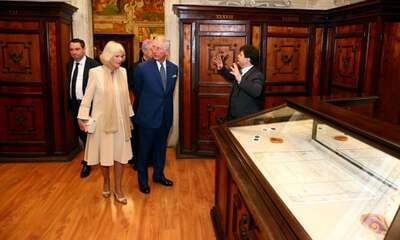 So here is Prince Charles, the would-be (will-be) King Charles III, wandering around looking at this priceless rubbish. It still forms the basis for governance within the United Kingdom of 2020, because Charlie will one day become the latest Supreme Head of the Church of England. When Henry VIII broke with Rome and absorbed this duopoly resting upon a myth, it became cloaked in the Crown as a corporation sole. It had two mirrored operations. In fact, in 1989 when James Murphy went out into the North Sea to watch the Dutch board the radio ship mv Ross Revenge, he was already wearing the hat of an Investigator for the Official Solicitor who was representing the Secretary of State for Trade and Industry. Meanwhile, another Official Solicitor was busy taking care of the affairs of the Church of England. Things got complicated after Henry VIII, what with revelations of a hoax while continuing on as if it was real, because England got involved in a series of civil wars. In the 1600s these wars also engulfed the separate Kingdom of Scotland and of course, the separate Kingdom of Ireland. In 1649, King Charles I had his head chopped off, and then first England, and then Scotland became a unified republic under Oliver Cromwell. Only it didn't quite work out, and so when Cromwell died the republic was overthrown and a new monarchy was created in 1660 with a King Charles II. But England and Scotland and Ireland were still all separately reigned over by Charles II, and the populace was spied upon by the creation of a General Post Office that censored the mail. Then Charles II died and the next king was overthrown by a Dutch invasion that the Crown tries hard to this day to pretend was not an invasion. Eventually the separate kingdoms of England and Scotland were joined together in 1707 as the sole Kingdom of Great Britain. The American colonies then seceded from it in 1776. In 1801, the United Kingdom minus America, then added the Kingdom of Ireland to its fold, and that led to another civil war gaining freedom for most of Ireland. All the while this nonsense that began back with Sylvester and Constantine has been continued as part of 'British' pomp and circumstance that is called the Crown. Since it was this Crown that advanced the cause of slavery in North America and elsewhere, if 'Black Lives Matter' are half-way serious, they will stop toppling statues and topple the British Crown corporation sole which is built upon slavery - of all peoples! 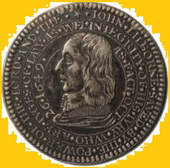 So now you know where we came in to this theater of the absurd that is called 'British History'. In fact, it was John Lilburne's fight for the right to freedom of the press and freedom of expression, that marked the 1985 beginning of our own trek back into the past of lost liberty and monarchical madness. It all began, as referenced in our previous Blog entry, with John Lilburne's acclaimed title of being 'freeborn'. In that 'Official Version' of the 1611 King James Bible, you should turn to chapter 22, and then go down the page to verse 28 of its Book of Acts. That is where you will find this reference to the Roman Empire and its citizens: "And the chief captain answered, With a great sum obtained I this freedom. And Paul said, But I was free born." The front of the medal shown above, was struck in John Lilburne's honor by a jury of his peers back in 1649, which is when he was hailed as 'Freeborn John' following a court trial. John Lilburne was nobody's "subject" or slave! We have elaborated upon his theme with our own academic monologue which is Online at: http://foundthreads.com/ [‘Me and my Shadow’ Reinterpreted: Collectivism Applied to Individualism as a Stereoscopic Overlay Producing an Illusion of Reality.] Now the stage has been set for us to finally explain why George Saunders looked around for someone to blame for the engineering mess on board the mv Caroline. That pending disaster now appears to be the work of intentional saboteurs striking back at the English for coming to Greenore, Ireland to work on a English offshore radio station. It became bathed in the cloak of the hated British Establishment, because its figureheads Princess Margaret and Jocelyn Stevens certainly did not represent the downtrodden hoi polloi of England, and no amount of blather by Ronan O'Rahilly fooled the people of Ireland that he was really running the show! Tomorrow we visit the cause of George Saunder's engineering nightmare. [Please note: Part of the text of this Blog entry has been rewritten due to the confusion created by the original text when trying to explain O'Rahilly genealogy.] 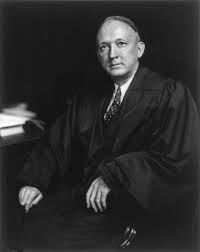 Back in 1985, we ('The Trio'), were engaged in an international radio project called Four Freedoms World Service (and a companion 4FTN on U.S. cable television.) At that time recorded music was still restricted on U.K. radio due to licensing contracts. We wondered why it was possible (at that time), to legally play rock 'n' roll all day on the radio in the USA, but not in the UK. We just happened to have a copy of the '1968 Yearbook of Encyclopedia Britannica' on the shelf in our radio studio, and it was flipped-open, more out of frustration than for any other reason, while pondering that question. We then came across an interesting five page article by the late U.S. Supreme Court Justice Hugo L. Black. [Picture above, right.] Cutting a long story very short, he attributed the basis for America's freedoms that are enshrined in its 1789 U.S. Constitution, to Englishman John Lilburne, who we had never heard of, before that moment. It was Black's article, which was apparently written by his wife, that caused us to embark on a quest to discover whether John Lilburne was related to Thomas Jefferson. We discovered that this question had been both asked and answered in a positive manner many decades earlier, and this in turn led to the creation of our own private research organization. Again, cutting a long story very short, this first discovery then led to the publication by us of a variety of monologues, books and broadcasts. You can still hear a recording of one of our earlier broadcasts about John Lilburne at https://www.mixcloud.com/mervyn-hagger/4fws-1989-part-two-john-lilburne-story/ [Caveat: This broadcast was made decades before we began to discover the real story behind the creation of Radio Caroline.] You can access some of our academic monologues Online at: http://foundthreads.com/02.html This is where our present investigation has led us back to our roots, because in the U.K., power has been imposed upon individuals via a Crown corporation sole. This entity claims a single right held in perpetuity that can deprive individual human beings of their natural rights and thus deprive them of the ability to control their own lives. Stated in stark terms, this is the issue that eventually led to the U.S. Declaration of Independence from the Kingdom of Great Britain.
In 1776, the Kingdom of Great Britain was composed of the Kingdom of England, which had already engulfed a geographical area called Wales; and joined it in a union with the Kingdom of Scotland. It was to support the power structure controlling this unholy alliance, that the British Crown which was (and is) managed from London, continued to feed upon their own financial stake in the African slave trade. But the same Crown structure, which already independently controlled the island of Ireland; in 1801 merged that island of Ireland into its 1707 creation called the United Kingdom of Great Britain. (England plus Wales with Scotland.) Now if you think for a single moment, that this so-called United Kingdom of 1707 has a continuous pedigree stretching back through the annals of time, you will be very mistaken. In fact, we have partially addressed this in our video found at http://radiocaroline.info In order to shut everyone up from asking questions, in 1660 an Act of Oblivion had been passed by the Kingdom of England, which happens to be when the General Post Office was created in London as a means of censorship. That same GPO then created the BBC and went to war against Radio Caroline. So we go around in a circle since it was the GPO that prevented broadcasting from developing in the UK, the way it had in the USA, and out of all that emerged Radio Caroline. But what we are now unveiling is the answer to the question of what was behind the creation of Radio Caroline? Well, the current brouhaha called 'Black Lives Matter' has a lot in common with Michael Joseph Rahilly. Neither movement is what it seems to be at first glance. Michael Joseph Rahilly who became known as 'The O'Rahilly' while assistant editor of the Irish nationalist newspaper 'An Claidheamh Soluis' ('Sword of Light') was a newspaper published by the Gaelic League. It served as the propaganda motivational source behind the failed 'Easter Rising' of 1916, which led to the death of Michael Rahilly. This is where the story behind Radio Caroline has been intentionally mixed-up with references to Michael Joseph Rahilly and the life of his son, who was the father of Ronan O'Rahilly. But again, and over a period of time, Egan John Eoin O'Sullivan O'Rahilly who was born in 1904 at Hove (Brighton), England, has embellished the story of his father to such a point that it must be revisited if we are to understand the background to the creation of Radio Caroline. This is also the same issue that Harry Spencer was confronted with at Greenore when Ronan's father turned his back on Harry because he was English, and it is the same issue that lay behind the mess that engineer George Saunders was told to go and fix by John Howard Gilman. That was the engineering disaster on board the mv Caroline, ex-Fredericia. It is therefore the same issue behind the problem that Ove Sjöström seems to have been unfairly blamed for. That issue and how it feeds through time from 1916 to 1964, will be further explained tomorrow in part 10 of the Nightmare at Greenore. 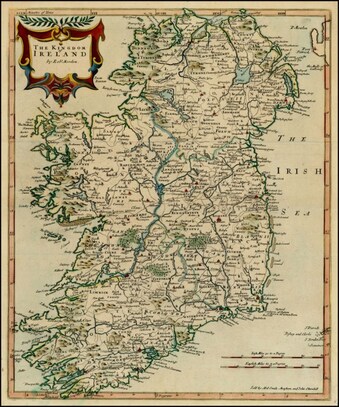 While not always intending to be political arch-propagandists, tellers of history are sometimes the most dishonest bunch of trouble-makers to ever populate this Planet. Their work is often the relied-upon excuse to start wars of so-called restitution or even retribution. That is why we do our best to avoid using the word history and call ourselves 'YesterTecs'. There is a difference; a big difference between historians and YesterTecs. Our approach is that of a team of detectives who are reopening and researching a cold crime case: a case where everything is claimed to have been settled, and where the "good" and the "bad" have already been identified and defined to the satisfaction of those telling the tales of history. Those are the tales oft-repeated by one Teller quoting another Teller. Yet there remains those vague blank-spots that no one else seems to talk about. That's where YesterTecs enter the picture! The story of the past as it relates to the archipelago known as the British Isles, includes the island of Ireland, a land drenched in blood of those wanting freedom by those wanting to dominate and control the inhabitants. As YesterTecs we examine all of the evidence, and as part of our own road to discovery, we have previously acknowledged the genealogical research work performed by Mark Humphrys: https://humphrysfamilytree.com/ORahilly/aodogan.html It is for similar reasons that we also acknowledge the work of: https://stairnaheireann.net/ It is from this source that we obtained both the antique map of Ireland by Barry Lawrence Ruderman, and other information that we now wish to draw your attention. That text appears under their heading of 'Key Events in Irish History'. We are not sure why, but in their timeline, number '9' is about the events of 1916, and that is followed by their number '10' concerning events that took place in 1972, which they have identified as referring to 'Bloody Sunday'. Their item '9' is headed: 'Sixteen Leaders of the Easter Rising are Executed'. In their reference paragraph that follows about "The men were leaders of the Easter Rising, which had exploded across central Dublin in late April"; there is no mention of 'The O'Rahilly'.
But since he was not that pioneer, fawning writers should have headed the advice given in the old TV commercial linked above. There is a lesson to be learned from that old TV commercial. Our own research into the origins of Radio Caroline has extended over decades, and it was by following various links and leads that we came across the person of 'Freeborn' John Lilburne. See: http://foundthreads.com/02.html Unlike Ronan O'Rahilly, 'Freeborn John' does hold valuable lessons for today, but again, unlike Ronan O'Rahilly, Lilburne has been ignored while the name of O'Rahilly has been promoted, and we would do well to see how that promotion of Ronan O'Rahilly began, and then became adopted for self-glorification. Now this brings us back to the person of Michael Joseph Rahilly who was born in 1875 and became involved with the Gaelic language revival movement. He then began restyling his name as "Rathaile" and "Ua Rathaille" and "O'Rahilly". Michael Rahilly; Rathaile; Ua Rathaille and O'Rahilly, is the person who died during the Easter Rising of 1916, and subsequently became identified as 'The O'Rahilly', as if there was only one of them. But there wasn't. We are inclined to think that Michael invented its use as a byline for his editorial work! But this is where the confusion begins with Michael's son Eon who began restyling himself as Aodogán when his birth names are Egan John Eoin O'Sullivan O'Rahilly. As we have previously noted, Aodogán was born in 1904 at Hove (Brighton), England, and like his dad Michael, he also married a U.S. citizen. All of this is extremely important because of the muddle that has been created as a result of these name modifications, and the true birth nation identity of the people concerned. This also bleeds over into the record of the Weatherwell company, and the property at Greenore. But we are taking all of this very slowly, one step at a time, because if ever there was a person who thrived on ambiguity and confusion, it was Ronan O'Rahilly! 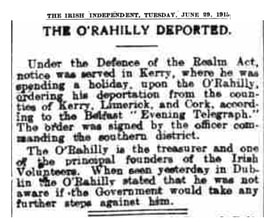 In 1914, here is Michael Joseph Rahilly who is being identified as 'The O'Rahilly, and marked for deportation. In this news item he is further identified as the Treasurer and one of the principal founders of the Irish Volunteers. That entity cannot be immediately linked to the Irish Republican Army (IRA), although it was a precursor to events that followed which did involve IRA. But they took place after the death of Michael Rahilly. Michael Rahilly, also known in 1914 as 'The O'Rahilly', was assistant editor and circulation manager of the Irish nationalist newspaper 'An Claidheamh Soluis' ('Sword of Light'): published by the Gaelic League. It became the propaganda motivational source that eventually resulted in the failed 'Easter Rising' of 1916, during which, Michael Rahilly died. 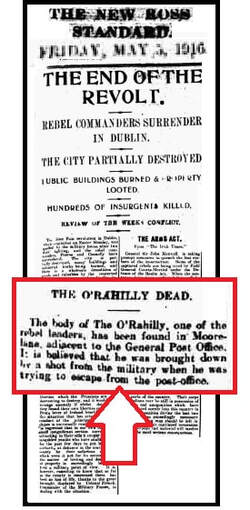 Then we come to this news item of May 5, 1916: "The body of The O'Rahilly, one of the rebel leaders, has been found in Moore Lane; adjacent to the General Post Office, I; it is believed that he was brought down by a shot from the military when he was trying to escape from the post-office." This contemporary news report is at variance with other versions about the death of Michael Rahilly, but it seems to point to the idea that he coined his own newspaper byline as 'The O'Rahilly' when writing as assistant editor. You may now wonder why that has any relevance at all to the issues at hand, and here is the reason why: Some have been in the habit of claiming that Ronan O'Rahilly's father owned the Port at Greenore. He did not. He managed a company, of which he was also a director, that did. As previously explained, it was its own entity and not one-and-the-same as Ronan's father. That company bought property at two separate auctions at two different times, and the property that the company bought was land and improvements that were adjacent to what had at one time been a ferry terminal. That terminal was not owned by British Railways, yet some claim that it was, and they also claim that Ronan's father owned the "private port" at Greenore, which he did not. So specifics are very important, and this is also true when it comes to laying down the genealogical foundation for the life and times of Ronan O'Rahilly! There was more than one Irishman (other than Michael Rahilly), who referred to himself as 'The O'Rahilly'. Not only that, but at least one other person has been identified in a newspaper with that same byline, and that person was not a member of the newspaper profession! "The devil is in the detail", and this is especially true when it comes to the work of unpicking all of the nonsense that has been written about the English-born father of Ronan O'Rahilly, whose father married a lady from Pennsyvania and gave Ronan an American-born mother!
Part 9 of the Nightmare at Greenore will continue here tomorrow. He's not back in the news, but he should be, because of the story now breaking today. What we want to know is: Who was Allan James Crawford? Was he a CIA or MI6 operative, or was he representing some other 'Deep State' organization? We do know that he was not just a music publisher who wanted to start an offshore station called 'Radio Atlanta'! Because at the very center of the storm now breaking in newspapers today, is Allan James Crawford. Back in 1975 he was on the front page of the Australian daily press, and that was "back in the day". But what "day" was that? It was during the Vietnam War when Australia had thrown in its lot with the USA and giant CIA bases were operating out of the Outback and on the Western coastline of Australia. 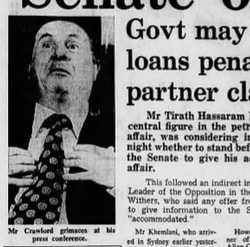 This is the same Allan James Crawford who begat Radio Caroline and used Ronan O'Rahilly as his agent who he sent to Houston, Texas in June 1963. Then that same Ronan O'Rahilly just 'popped-up' in the office of Jocelyn Stevens with his young buddies Ian Cowper Ross and Christopher Moore to begin the pretense that they had nothing to do with Allan James Crawford. But of course that was a lie, and it is the big lie that we are in the process of unmasking. When this news story broke today we decided to cover it - again! Yes, back on 5/29/2020 we ran a story titled: "Why we have no time for trolls". On our Comments forum the trolls keep trying to post their own rubbish, but now that we have a very strict policy against troll-type posts, they don't get on line. But yesterday, in addition to one from a whiner who even tried to blackmail us some time ago, another post came from a troll who wanted to know why we were bothering to include the U.S. Supreme Court interpretation of what a company is. The troll seemed to think that this is an exclusively British story.
Well, it's not! The answer to the troll's gripe has to do with content within context, and in this instance it is because the O'Rahilly family is really half-American with some English blood mixed in for good measure. Going back from Ronan to his father, and Ronan's grandfather, we find a family that is half-American and half-Irish. In the instance of Ronan's dad, who was born in England and lived in Ireland, well, as you will soon learn, he got a chunk of change from U.S. taxpayers on the basis of a business proposal that he changed, after he got the money! So what has any of this got to do with Greenore? The answer is that it has everything to do with Greenore which actually emerged from obscurity thanks to the generosity of the United States of America for rebuilding the nations of Europe after World War II. That is how Ronan's dad got his money for Greenore. Not only that, but Ireland was included in this USA financial bail-out, even though Ireland was a "neutral" nation (leaning in the Allied direction), during the War years. With Crawford turning out to be a real mystery man who is mired in deep-state geopolitics, and Ronan O'Rahilly acting as his stooge, it becomes really important to know who actually owned the assets of those radio ships used by Radio Caroline, and who owned the port facility where they were partially outfitted for broadcasting purposes. We have been assembling a lot of new material that you will not have seen before. It explains just how Ronan's father got involved with Greenore. We will be revealing who actually bought it and how they bought it, and where the money came from. In the meantime, check out this interesting story .... https://www.theage.com.au/national/how-the-loans-scandal-became-an-affair-to-remember-20050101-gdzadn.html because at its core is Allan James Crawford who died in obscurity in Wales, UK. His companion in the loans scandal who put Allan James Crawford on the front pages of Australia's daily newspapers, was Tirath Hassaram Khemlani, and guess what? He died in obscurity in Scotland, UK. Well, this is where obscurity ends for all of them, including Aodogán O'Rahilly and the company known as Weatherwell Ltd., which he managed. Aodogán O'Rahilly did this with help from the U.S. government and its generous taxpayers, and although Aodogán O'Rahilly has gone into the anorak history books as the owner of the port at Greenore, like most things in those books, it is not true at all. Part 8 of the Nightmare at Greenore continues here tomorrow. 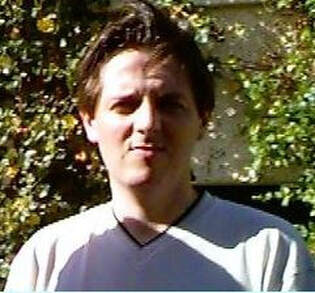 As best I can determine because it lacks a caption, this is a picture of Dr Mark Humphrys that he put on line in 2004. His image should make every professed anorak cringe, because Mark is the sort of person who could sweep the bogus claims of Ronan O'Rahilly into a dustbin; but unfortunately for us, that has not been the focal point of his attention. Dr Humphrys lays claim to the oldest continuous family blog in Ireland, and his research shows that it is second-to-none. Unfortunately for those interested in offshore radio history, Mark's sideline interests began with investigating the history of a motor car, and then they expanded into his own, and his wife's genealogical trees. As a professional, Mark's professional roots are in academia, with a specialty in the subject of Artificial Intelligence. But thanks to his own current Blog and related web site pages linking to the Wayback Machine, we have access to his earlier work and it incorporates by various links, details that relate to the genealogy of the O'Rahilly family. [See http://web.archive.org/web/20040603153956/http://www.compapp.dcu.ie/~humphrys/index.html ] As I first explained several days ago , there are many who want me to "get on with it", but as I have also repeatedly explained, "the devil is in the detail" and the detail (or the devil), cannot be rushed. This is very true when it comes to understanding the fine print that is contained in legal contracts, and it is to an understanding of that kind of law that we turn to next. At least one troll has insisted that Egan John Eoin O'Sullivan O'Rahilly, who styled himself as Aodogán, bought the old railway terminal at Greenore. As I previously stated, that is untrue. The troll then responded by citing a late-in-the-day report from Liverpool which merely made a connection without in-depth explanation. But again, "the devil is in the detail", and for this we need to spend a moment understanding the legal differences between a human being such as Aodogán O'Rahilly, and the business ventures that he was involved with. Yesterday, I quoted a Ms. Sweetman who spoke about her Uncle Aodogán, and she stated that ".... as a very young man he started his own tile manufacturing company, Weatherwell Ltd, and later he formed Greenore Ferry Services, and he ran these successful businesses for many years." As stated, that explanation is perfectly fine, and there is nothing wrong with it. But, if like a troll, Ms Sweetman had said ".... as a very young man, Uncle Aodogán started manufacturing tiles and later he bought the Port of Greenore and the railway station"; that statement would be totally false. The question that must be addressed for a lay audience, is why would it be false? The answer is found in the legal definition of the word "company" which is a legal word referring to an entity that can be created in various formats. These variations depend upon the purpose of the company, and the company must set out in text its raison d'être within Articles of Incorporation (or documents submitted for Registration), which may also be defined as the Constitution of that Company. It is more than a human birth certificate, because a human birth certificate does not demand an explanation why human parents decided to engage in sexual activity with the premeditated intention that it would result in the birth to a newborn human baby; but the creators of a company do have to explain the intended purpose behind their motivations. A legal company can be registered as an "artificial person" with limited liability attached to its members, as long as they abide by their legal obligations to the "artificial person", or company. An "artificial person" or company has a 'life' of its own; a 'personality' of its own. In the USA, back in 1819, Supreme Court Chief Justice John Marshall stated that such an entity ".... is an artificial person, invisible, intangible, and existing only in contemplation of the law ...." [See 'Trustees of Dartmouth College v. Woodward, 17 U.S. 518 (1819) at: https://supreme.justia.com/cases/federal/us/17/518/ ] Therefore it is totally incorrect to state that "Aodogán O'Rahilly started manufacturing tiles and later he bought the Port of Greenore and the railway station". Let me make this very clear, Aodogán O'Rahilly, that is, the father of Ronan O'Rahilly, did not buy, and therefore he did not own, the "private port at Greenore", as so many anoraks are want to say!
Now why is that important? Because if Aodogán O'Rahilly did not buy the "private port at Greenore", and someone else did, and that "someone else" is an "artificial person", then we should not be focusing upon the human person of Aodogán O'Rahilly. Instead we should, and we will be focusing on the "artificial person" that is, or as it should now be written: 'was', since 'it' is now deceased, that company known as Weatherwell Ltd., and that is precisely what we will do, tomorrow. There are trolls out there who insist that Egan John Eoin O'Sullivan O'Rahilly who was born in 1904 at Hove (Brighton), England, bought the old railway terminal at Greenore. He did not. But the troll approach is to speak and write in generalities, but I am communicating in 'legal-speak' where "you know what I mean", doesn't cut it. The plain fact of the matter is that Ronan's dad did not buy the old Greenore railway station; nor the old Greenore railway hotel. It's amazing that I know anything about Ronan's dad, because so little has been written about him. Come to that; it is also amazing that so little has been written about the early life of his son Ronan O'Rahilly. In fact, the entire O'Rahilly family is cloaked in obscurity! But, if you pick up one of the 'know-it-all' anorak books, well, they will tell you everything; just like the trolls who buy and read them. The only problem is that what they tell you is rubbish! Some are complaining that this entire recital is taking too long and it is too meticulous in its detail, but that is because it is as accurate as it is possible to be, at the moment. In fact, if more details come to light, they will be included in this recital which will eventually find its way into part of the text within a book format. Before we delve into what the son of Egan John Eoin O'Sullivan O'Rahilly is alleged to have done, I am going to concentrate on what his father actually did. We begin with this composite map: 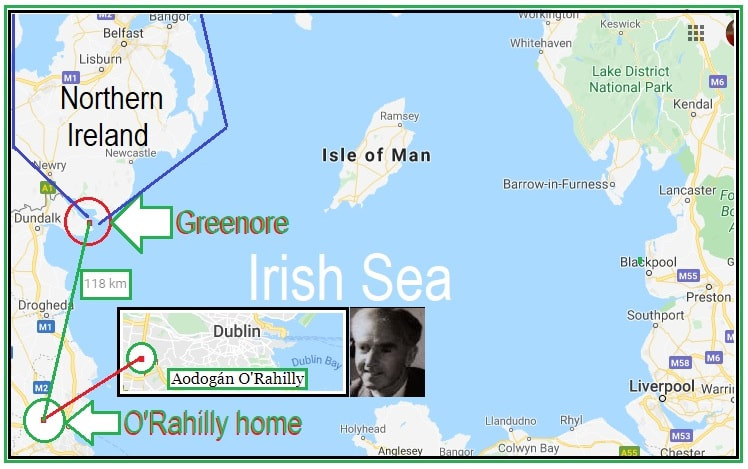 First of all let's talk about the lineage of England-born Aodogán and his Pennysvalia-born wife Marion. Their offspring, in order of birth, are: Nuala O'Rahilly Eoin O'Rahilly Ronan O’Rahilly Roisín O'Rahilly Iseult O'Rahilly Now a lot of what we have come to know about Ronan's grandfather has come from the pen of his own father. Snippets have been vacuumed up to compile a book, or two. Others have then incorporated that work and amplified it. But what do some of those closest to 'The O'Rahilly' have to say to others about their kinfolk? Well here is one example, and we will comment on its accuracy or otherwise, a little later on: On May 23, 2017, this item appeared online at http://lattongaa.com/visit-ruth-sweetman/ It is an article about a Ms Ruth Sweetman in which she spoke to an assembled gathering about her kin folk. Her own 'claim to fame' arises from her relationship to the man who has become known as 'The O'Rahilly', whose proper name is Michael Joseph Rahilly. [See the genealogy listing in yesterday's Blog.]
(Ms Sweetman’s grandfather is) 'The O’Rahilly' (and he) had 4 younger siblings: Aodogán, Niall, Maolmuire and Ruairí. 'The O’Rahilly', had lived in America just after his marriage and again a few years later, and the family finally returned to live in Ireland in 1909. On his return to Ireland he was motivated by the wish to ensure a sound education for his sons, and she knows that her father .... qualified as an accountant and later still as a barrister in the mid-1930s. She praises her Uncle Aodogán’s book 'Winding the Clock: O’Rahilly and the 1916 Rising', and she thinks that he was most like his father in his innovative nature. As a very young man he started his own tile manufacturing company, Weatherwell Ltd, and later he formed Greenore Ferry Services, and he ran these successful businesses for many years. He was also involved in the initiation of Bord na Móna. Ruth feels that the tragedy of her grandfather was that he realised that the Rising could not succeed. His famous remark: 'I’ve helped to wind the clock, I’ve come to hear it strike' is recalled ...." Key to understanding what happened at Greenore, is an understanding of what 'Weatherwell Ltd' was all about, and that is what we will take a closer look at in tomorrow's Blog. 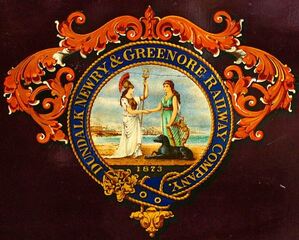 The reason why this Blog is called a 'Media-Microscope' is because this is a 'cold case' investigation where the true story is only now being revealed for the very first time - by anyone - by focusing on that idiom "the devil is in the detail". Unlike that idiom, which apparently no one is sure how it originated; details involving the creation of Radio Caroline can be taken apart, line item by line item, and we can know much more about the real story behind the creation of Radio Caroline. Fortunately we have a road map. Actually, it is a railroad map that when followed, leads to the clues necessary to unraveling this mystery that so many writers have glossed over. Once we know the foundational details, then we can get back to addressing the problems that Harry Spencer ran into with a firm at Dundalk, and from there, we can also begin to comprehend the mess that George Saunders ran into. So although this is extremely tedious work, it is also extremely necessary: because no one else has been willing to microscopically analyze the details before now, and it all begins with a coat of arms for a defunct railway company. However, I should also add that a basic grounding in relatively recent Irish history, and the genealogical record of the O'Rahilly family, must also be reviewed in conjunction with the geo-political lines drawn on a map of Ireland, in order to understand just what did happen, and why it happened in 1964 at Greenore. This is why this we need a 'media-microscope' in order to spot the 'devil in the details' that all of the other writers have obscured from view. Fortunately for us there is an expert in untangling the story of the O'Rahilly family, and it can be located at https://humphrysfamilytree.com/ORahilly/the.orahilly.html Here is an abbreviated version:  1. Michael Rahilly was born c.1765. He was always listed as "Rahilly" and not "O'Rahilly". Michael Rahilly married Ann Sullivan c.1795 and died c.1820. Their lineage included:  2. Michael Joseph Rahilly was born in 1810 and in 1836 he married Margaret McEllistrem. He died in 1849. Their lineage included:  3. Richard Rahilly was born in 1839. He married Ellen Mangen in 1868 and died in 1896. Their lineage included:  4. Michael Joseph Rahilly was born in 1875. He sailed for New York in 1898 where he married Nancy Brown in 1899. Both were wealthy and their honeymoon was a tour of France, Austria and Italy. They returned to New York and had a child in 1900 and in 1902 they traveled to Ireland and had a son who was born in 1903. In 1904 they moved to Hove, England where Egan who became known as Aodogán, was born that same year, and then they went back to the USA to take over his his wife's failing business in Philadelphia, Pennsyvania. The couple returned to Ireland in 1909, and that is when Michael Joseph Rahilly became involved with the Gaelic language revival movement and began restyling his name as "Rathaile" and "Ua Rathaille". He began calling himself "The O'Rahilly" in 1911. In 1916, with the Rising about to draw to its failed conclusion, ".... he led 12 volunteers down Moore Street in Dublin in an attempt to set up another garrison. However, he was shot and died in a doorway." (Quoted from: 'The Irish Times': 'O'Rahilly memorial unveiled in Dublin'; Saturday, April 30, 2005.) His wife Nancy died in 1961. Their lineage included:  5. Egan John Eoin O'Sullivan O'Rahilly was born in 1904 at Hove (Brighton), England. He later began writing his first name of Egan as Aodogán. In 1934 he married Marion O'Connor who was possibly born in Philadelphia, Pennsyvania. Her father had emigrated from Ireland as a boy. In 1932, it is claimed that Aodogán and Marion bought their house plans for a future home in Ireland, from Macy's Department Store in New York City. It has been claimed that these plans represented 'Macy's 1932 House of the Year' which had been built inside the store. However, that information has not been verified by other sources at this time. Marion died in 1994, and Aodogán died in 2000. To be continued tomorrow. [Amended text on July 19, 2020 to incorporate item from 'The Irish Times' regarding the death of Michael Joseph Rahilly, ("The O'Rahilly").] |
Our team produced this free radio program for PCRL in Birmingham.
It was repeatedly broadcast on and after October 20, 1985. Click & listen! Blog Archive
August 2023
Copyright 2021 with all rights reserved.
|
Index |
Library |
|
